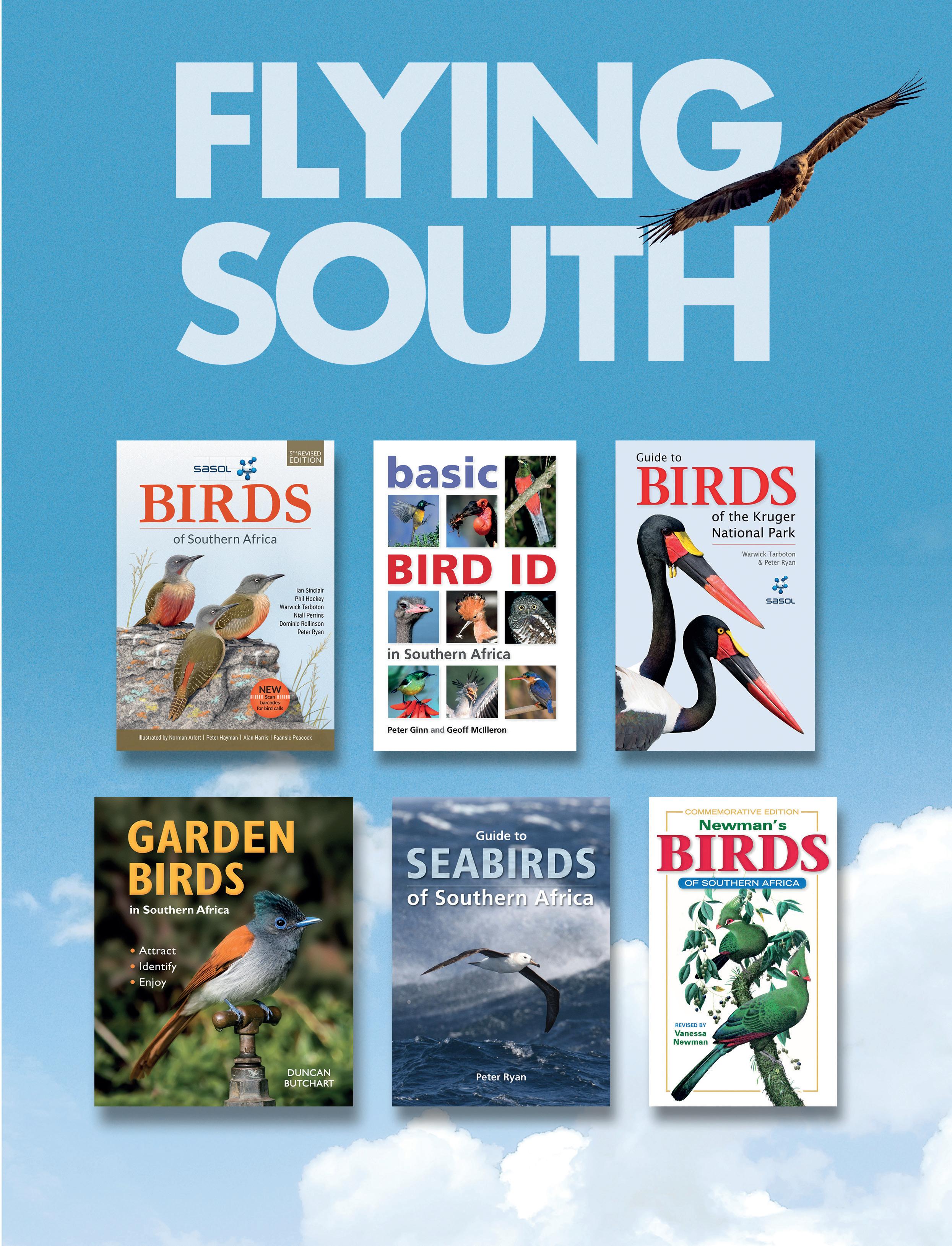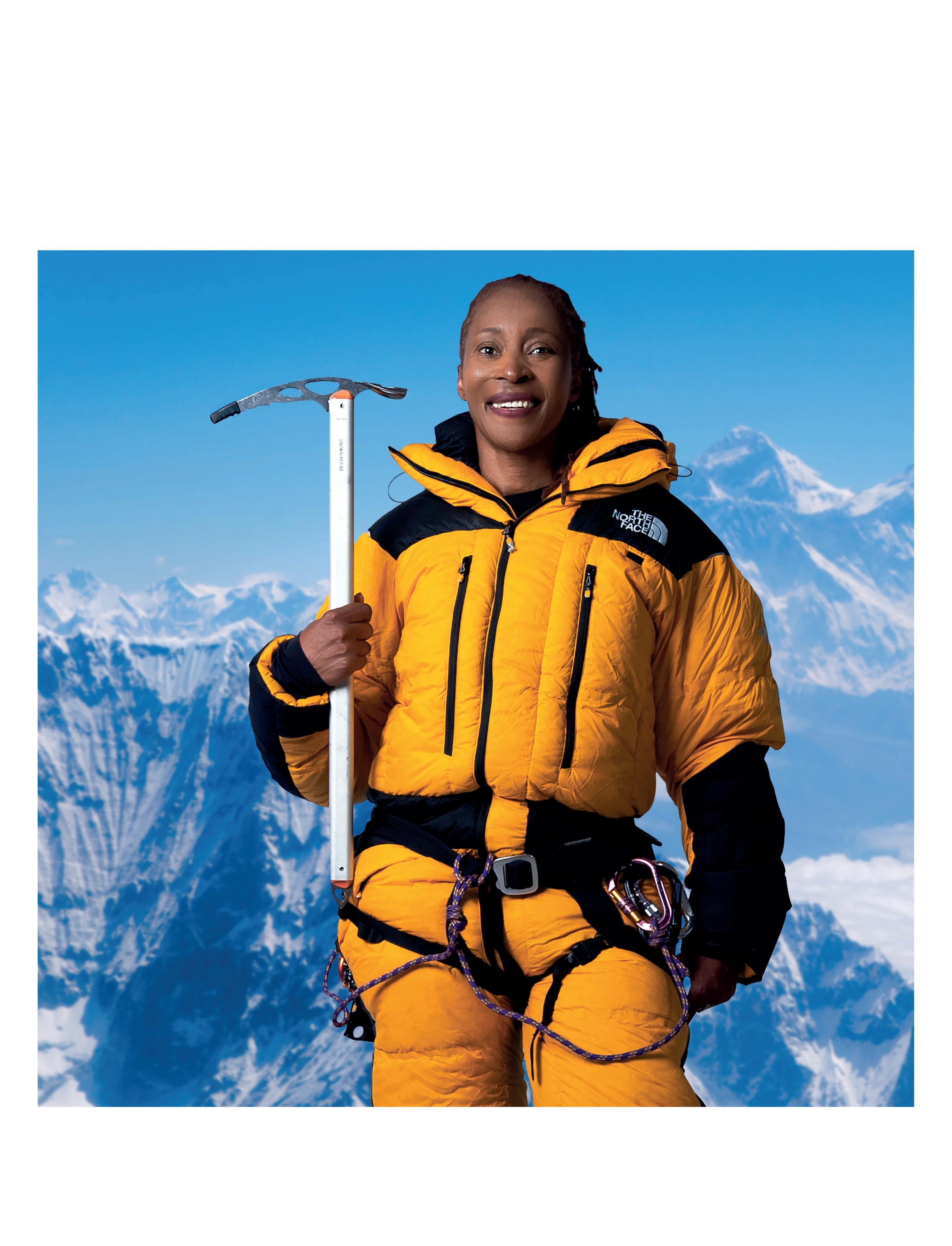

THE PENGUIN POST

Books to help you navigate the potholes of modern living
in this magazine are those of the authors and do not necessarily reflect
and opinions
The
02
BOOKSCAPE A new book from Richard Osman, #bookstagram Must of the Month and Five Minutes with Onke Mazibuko
05
GIFT GUIDE Exciting reads for the coolest dad around on Father’s Day
06 COVER The first black African woman to summit Everest, Saray Khumalo, on going beyond her limitations
10 AT MY DESK Paddy Crewe on his brilliantly original debut, My Name is Yip, and our bumper round-up of the best in fiction
13
BOOK CLUB A daily train commute sparks unlikely friendship in Clare Pooley’s brand-new feel-good novel
14ON WRITING The Heist Men author, Andrew Brown on the process of developing a character
15 MEET THE WOMEN’S MURDER CLUB
The stars of James Patterson’s hit mystery series
16
INSIDER An intriguing extract from James Patterson’s brand-new autobiography
18 COMPELLING EXTRACT
From the memoir of one of SA’s most prolific businesswomen, Magda Wierzycka
19
WELLBEING The art of leaning into the bittersweet, according to Susan Cain
20 PROMO Good vibes are at your fingertips with our round-up of the best in mind, body and spirit
22ADVICE Achieve financial longevity with advice from Wynand Gouws
23
NATURE An ode to the universe from astronomer Auke Slotegraaf
27
FOOD A collection of local is lekker recipes from this season’s hottest cookbook authors, plus a wine pairing
32 ON MY MIND Kyle Cowan on recognising how Eskom poses a threat to South Africa
Johannesburg | Growthpoint Business Park, Unit 12A, 162 Tonetti Street, Halfway House Ext 7, Midrand, 1685 | 011 327 3550 Cape Town | Estuaries No 4, Oxbow Crescent, Century Avenue, Century City, 7441 | 021 460 5400
© Copyright Penguin Random House South Africa (Pty) Ltd. The Penguin Post is published by Penguin Random House South Africa. All rights reserved. Reproduction without the written permission of the editor is strictly forbidden.
Editor Lauren Mc Diarmid Designer Sean Robertson Sub Editor Frieda Le Roux
Contributors Andrew Brown, Auke Slotegraaf, Kyle Cowan
Welcome!
After two years, we thought it was time for a makeover ... We're thrilled to reveal this new revitalised version of the magazine, now printed in a beautiful glossy format, and with 12 extra pages. Some of the exciting new additions include a spot for you to have your say - and win! - with our Reader's Letter section, an extended Nature feature, which I know is a favourite amongst many of you, and a long-anticipated wine page. So enjoy, and please give us a shout to let us know what you think!
Also, don't forget that you can get our bumper version of the mag - with extra author interviews, recipes and extracts - straight to your inbox each month. Simply visit www.penguinrandomhouse.co.za/newslettersubscription-form to sign up.
Our cover star, Saray Khumalo, is quite possibly the most inspiring person I've ever met. Her memoir, My Journey to the Top of the World, begins with her modest start in Zaire and Zambia and ends with her on top of the world, at the summit of Mount Everest. So many of us could only dream of taking on such a daring journey but, for Saray, this was her purpose; her way of challenging the limiting stereotypes that so often bog down black African women, and changing the minds of the people who thought she couldn't do it. All while tackling illiteracy through her fundraising efforts. Saray is a phenomenal person, whose story will stick with me. I can't recommend her book enough.
There's so much more that I know you're going to love in this issue, so settle in, and happy reading!

Lauren Mc Diarmid
ThePost@penguinrandomhouse.co.za
bookscape
news | snippets | what’s new
Everyone’s talking about …
The
Third Book in
Richard Osman’s
Thursday Murder Club Series
We are excited to announce the publication of The Bullet That Missed by Richard Osman, coming September 2022. This is the third book in the Thursday Murder Club series from million-copy bestselling author Richard Osman, about four unlikely friends living in a peaceful retirement village who meet up to investigate unsolved murders – and we can’t wait to read their latest mystery!
In The Bullet that Missed, it is an ordinary Thursday, and things should finally be returning to normal. Except trouble is never far away where the Thursday Murder Club are concerned. A local news legend is on the hunt for a sensational headline, and soon the gang are hot on the trail of two murders, 10 years apart. To make matters worse, a new nemesis pays Elizabeth a visit, presenting her with a deadly mission: kill or be killed... While Elizabeth grapples with her conscience (and a gun), the gang and their unlikely new friends (including TV stars, money launderers and ex-KGB colonels) unravel a new mystery. But can they catch the culprit and save Elizabeth before the murderer strikes again?
The Bullet that Missed hits shelves September 2022.
DOMINATING THE BESTSELLER LISTS
“The Milk Tart Murders is a wonderfully easy book to read. Sally Andrew’s unexpected turns of phrase leave one laughing out loud, along with several “didn’t see that coming” plot twists and turns. Her characters are larger than life – some much larger –but all totally believable. I can truly recommend it.”
– Barry Meehan, ArtSmart
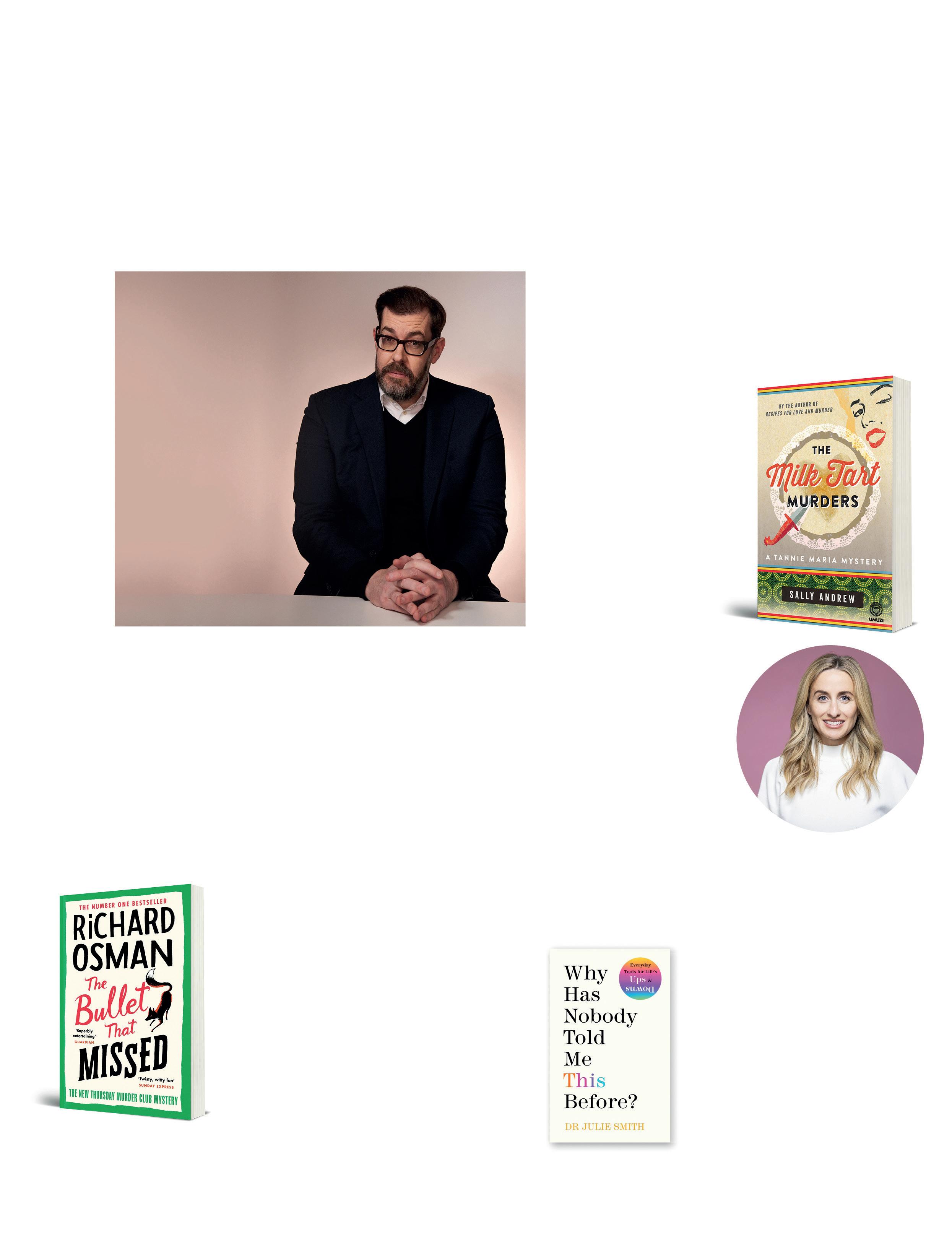
If we don’t do the work to develop selfacceptance, we set ourselves up to live a life in which we may need constant reassurance, get trapped in jobs we hate or relationships that cause us harm, or find ourselves living with resentment.
– Julie Smith, author of Why Has Nobody Told Me This Before?
#bookstagram MUST
of the MONTH

@flowergirlbooks
6.8k followers
WIN! WIN! WIN!

Every month, we have loads of books and other great prizes to give away. To find out more, scan the code using your phone camera, or visit www.penguinrandomhouse.co.za/competitions.
Dear Editor
When shopping at Exclusive Books, I was handed a copy of The Penguin Post. How delighted I was to read the article by Sally Andrew (On my Mind: Letting Go, Volume 14). I was hooked on Tannie Maria from the very first chapter and am so looking forward to The Milk Tart Murders
We’re both delighted and apprehensive about screen rights. Will it be like Harry Potter, we worry? Great when the movies began (except for not ensuring Harry wore green contact lenses), but which slowly deteriorated by being Americanised with important bits left out (especially in The Goblet of Fire. It should have been two movies, not one!).
Then there was the brilliant No. 1 Ladies Detective Agency television series, which stuck to Alexander McCall Smith’s books and had the perfect ‘traditionally built’ actress for Mma Ramotswe.
Don’t miss out this month ...
1
Emotion by Design by Greg Hoffman
Nike’s former Chief Marketing Officer helped craft the company’s iconic campaigns for Ronaldo and Serena, Olympic Games and World Cup finals. Together, his insights offer a revelatory method that will make any brand more creative.
Bricks for Chicks by Tanya Haffern The book aims to grow the reader’s financial skill set to acquire the confidence to become financially independent. For anyone who wants to start investing in property but feels overwhelmed by the terminology, expenses and inherent risk, this book is going to change her life.
3 2 RELEASE RADAR
The Palace Papers by Tina Brown Full of powerful revelations and exclusive access, The Palace Papers dramatically chronicles one of the most tumultuous periods in the recent history of the monarchy. It will irrevocably change the way readers perceive and understand the Royal Family.
No wonder you had trouble signing over control, Sally. Our hearts go out to you. If we, the members of your fan club, are already having apprehensive twitches, how hard it must indeed have been for you to ‘let go, let go, let go’.
May the casting gods be with you and the beautiful Karoo settings, just as you have so eloquently described them, play a major role.
Our hope is for you (and us) to partake of a perfect omelette full of all the right ingredients.
Warm regards,
Jacci Babich
Jacci’s letter has won her a hamper of three books featured in this issue!
Want to stand a chance at winning?
Email your thoughts in a letter to ThePost@penguinrandomhouse.co.za, and we might just feature it here!
Five Minutes with … ONKE MAZIBUKO
The Second Verse is a debut novel about the coming of age – and therefore also the mental wellbeing – of a teenage South African boy. Why? When I first read JD Salinger’s Catcher in the Rye in high school, I did not enjoy it. Reading it again when I was in my twenties, I was blown away by how much I connected with the protagonist. I read it again in my thirties and enjoyed it even more. It gave me the thought that maybe we, as people, are always coming of age, and adapting is critical for our mental health.
The book speaks equally to the adult and young adult markets. How did you manage that? While writing the book, I thought a lot about what I needed as a teenager, both in terms of emotional and mental support. I also thought about what I have to give, as an adult approaching 40, in terms of nurturing. In a sense, I was always trying to create this dialogue between the younger and older versions of myself.
Creativity is a lifeline and seems to help Bokang coping with his circumstances; can you tell us more? Self-expression, especially of talents and passions – is critical not only for identity but for building resilience, too. All children naturally express themselves creatively. Unfortunately, as they grow older, many of them are convinced by the world that creativity is only for some.
You are a psychologist working with youth. Was it your work and the issues today’s youth have to deal with that inspired you to write the book? Absolutely. As a psychologist I get to see how people mistakenly think that what they go through mentally and emotionally is unique to them. I wanted to tell a human story that many people could find relevant.
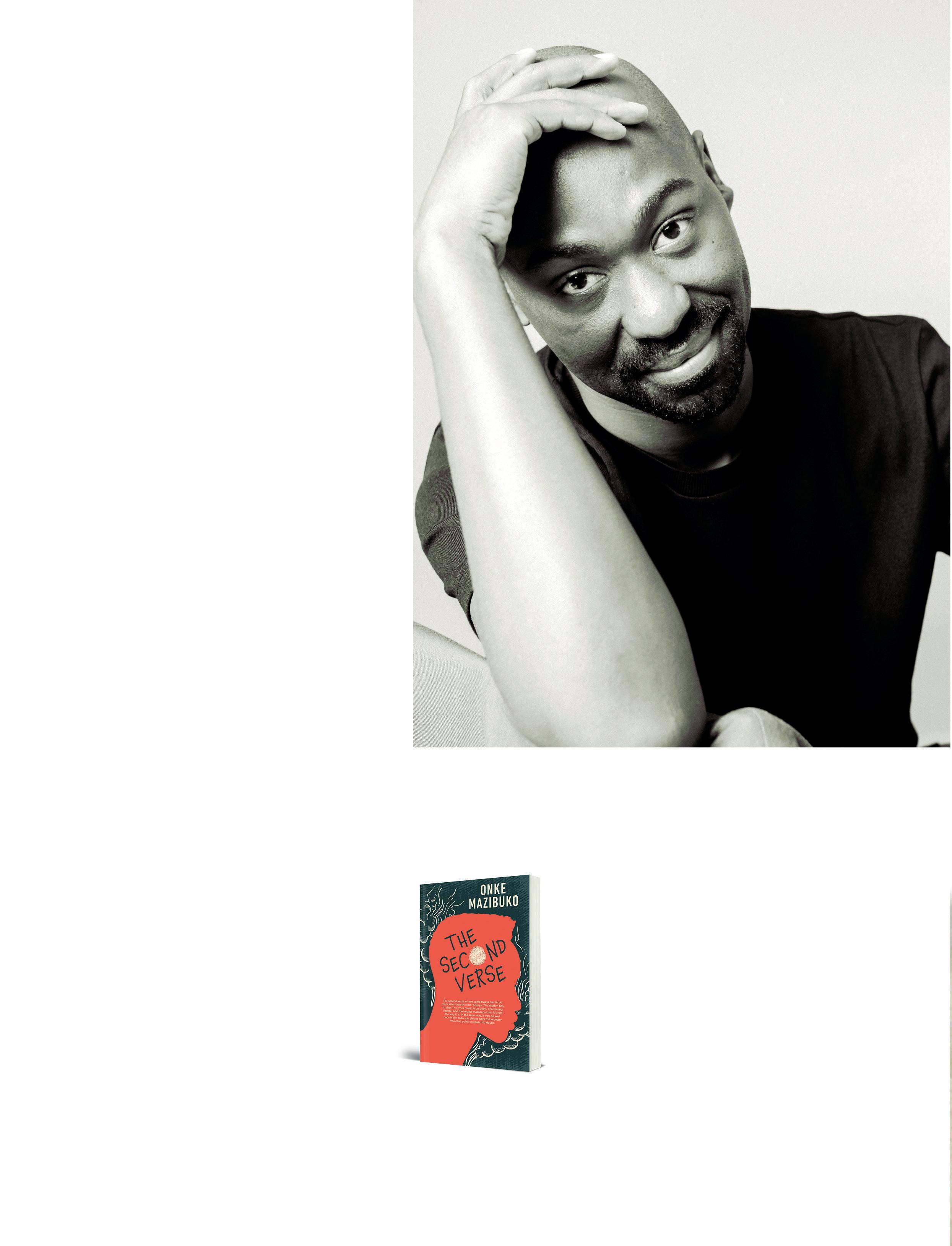
The Second Verse is out now.
Today’s youth appear to be pulled into the world of adults sooner than previous generations, but paradoxically they are more reluctant to adult in the same way as previous generations. I often tell young people that when I was 15, I was still into climbing trees. Today’s teenagers have too much information at their disposal to be climbing trees.
Why is it set in the late 1990s? The simple answer is that I was a teenager during this time. The complex answer is that I didn’t want social media and its inherent psychological implications to be an element of this story, and it would have been difficult to tell a story about a teenager without that aspect being central.
FOR THE DAD AROUND
The best Father’s Day gifts for Dad include an explosive James Bond thriller, an unorthodox guide to making things worth making and a gripping series about a former major in the U.S. Army-turned-wanderer and private investigator.

With a Mind to Kill by Anthony Horowitz
In the explosive new James Bond novel, it's M’s funeral. One man is missing from the graveside: the traitor accused of M’s murder –James Bond. In a mission where treachery is all around and one false move means death, Bond must grapple with the darkest questions about himself.
Build by Tony Fadell
For every career crisis, every fork in the road, you need someone to talk to. Someone who's been there before, who can give it to you straight. Enter Tony Fadell who has built some of the most impactful devices in history – the iPod, iPhone, and Nest Learning Thermostat. He has enough stories and advice to fill an encyclopedia.
"REACHER SAID NOTHING."
… but the actions of the roaming, exmilitary, coffee-drinking hero of Lee Child’s beloved series speak volumes. And so do the numbers: Now on its 26th novel, and with a new co-writer in the form of Child’s writer brother, Andrew Grant, a book from the series gets bought every nine seconds! Jack Reacher has also been the star of two films and an Amazon Prime television series. If Dad isn’t already a fan, why the heck not?
Cloudmoney by Brett Scott
A revelatory story about how the fusion of big finance and tech requires physical cash to be replaced by digital money underpinned by the banking sector, or ‘cloudmoney’. Diving beneath the surface of the global financial system, Brett Scott uncovers a longestablished lobbying infrastructure waging a covert war on cash.
Going Beyond Limitations
Saray Khumalo was the first black African woman to summit Mount Everest, in a feat that took her four attempts. Many would have called it quits, but for Saray, this was about more than climbing a mountain; this was her purpose, and she would do whatever it took to see it fulfilled.
“Once you know your purpose, you’ll do anything to fulfil it. It helps bring clarity to life, and drives you in that direction, no matter what might get in your way.
It’s not always the most straightforward thing to figure out, though. It comes from a deep introspection into what's important to you, what you want to be remembered for, and what impact you want to leave on your children and community, long after you've left this earth.
Answering those questions in earnest makes it easy to know what it is you need to do and, with the fragility of life, also comes this sense of urgency to get to it. It suddenly becomes easier to let go of the things that are not important – the things that don’t contribute to us fulfilling our purpose –and start making the decisions that put us and our ambitions first.
It was in 2009 that I was forced to take stock of my own purpose when my older sister Florence died suddenly. It was completely devastating, and it prompted deep reflection in me. I remembered my grandfather’s words: ‘If you don’t live a life of service, that’s a life wasted.’ I also recalled my mother’s words: ‘The sky is the limit. Go for what you want.

I had wanted to make a big impact, somehow. To make a difference and have a sense of purpose.
You are everything you need; nobody should tell you any different.’
And I wondered, had Florence actually lived her purpose? Was I living mine? If I was being honest, the answer was no.
What followed was a reflective journey, spent thinking about my youth and about what I’d hoped for and dreamt about. I had wanted to make a big impact, somehow. To make a difference and have a sense of purpose. So that’s what I was going to do.
After many months of pushing for that, my journey led me to the position of Employee Number 2 Discovery Bank. Here, I had access to some of the best global behavioural economists and great minds within the group, with a commitment to making South Africa great. I’d finally found the sense of excitement and purpose I’d been looking for.
We were encouraged within our departments to adopt charities, and ours was Kids Haven. We organised fun outings for the kids and, because this cost money, I would go around the office after payday each month asking my colleagues for donations.
It was during this time that a colleague of mine mentioned she was going to climb Mount Kilimanjaro with her friend and her sister. I’d had the idea to do it myself, ever since an American guy who’d done it

had planted the seed in my mind in 1996. With no serious limitations holding me back, I knew my moment had come.
At the same time, I still had Kids Haven on my mind, and it struck me that we could combine the two in a fundraising effort. My Kilimanjaro climb in December 2012 was the early beginnings of Summits with a Purpose, a foundation I started in 2013, using my climbing expeditions to raise funds for literacy and educating young people, while uplifting economically marginalised communities in Africa. I couldn’t have imagined then how the cause would take off, particularly during my expeditions to Mount Everest.
I had taken on Everest three times before summiting on my fourth attempt in 2019. I felt such a strong sense that we can all go further and higher than we imagine, a feeling that I’ve retained and have wanted to impart to younger people – they can go above the clouds; in fact, that’s where they should be.
While I hadn’t thought about what my achievement might have meant to others, when I returned to SA, I saw that people were actually listening to what I had to say. I realised that I had the power to either

I had the power to either build up people's confidence or break it down.
build up their confidence or break it down. So, I made it my mission to become the type of person to stretch out a hand to lift others up. To show them that they could also do what I did, and more, becoming their own kind of superhero.
Are there going to be bad days? Definitely. But it’s about waking up every day knowing it's another chance to try again. Even if you take one step, that’s okay; you're working your way up slow and steady, and that’s what matters. If I could look up at Everest from Camp 4 on my third attempt, with tears in my eyes, thinking, So close, yet so far, and still go back a fourth time to make history, then anything is possible. You just have to keep stepping.
In putting the book together, I was transported through the wild ride of emotions I felt with every expedition. There was the anger when people questioned what I was doing there as a black woman. The defiance in going back time and time again to show them that I – that we – can do it. The pride, because I did it and I paved the way for another African child who can go through the same lifechanging experience, but without the stigma.
I revisited how me not giving up changed
people’s perspectives. There was the German climber I met on Argentina's Mount Aconcagua who, for the rest of his life, will look at my people differently, because I summited and he didn’t. And on a more personal level, with my sons. My eldest told me after I summited I’d proved to him that nothing replaces hard work. He has this optimism now around what he’s able to do in his own life because I took that extra step in mine.
I knew this was how I was destined to make a difference in the world.
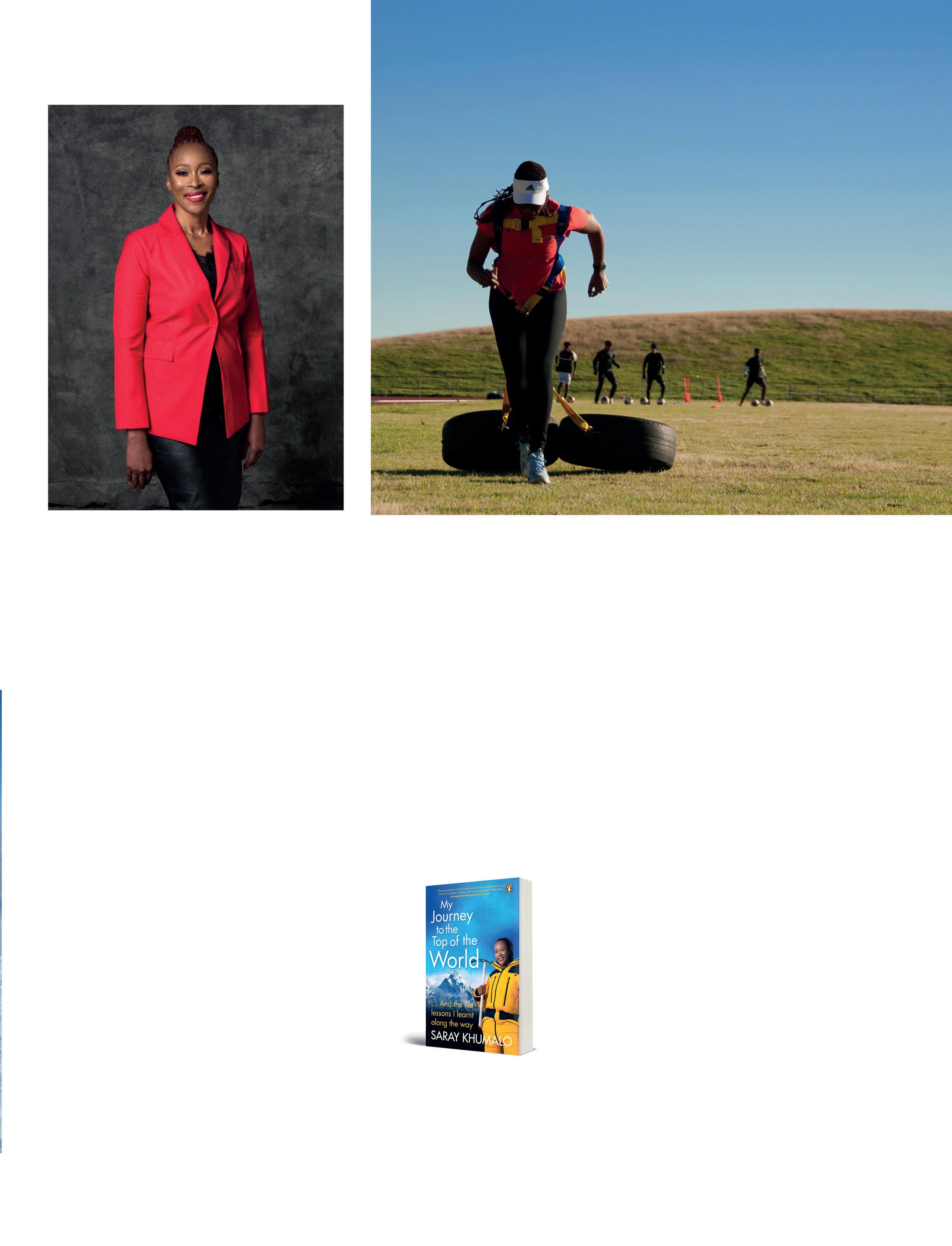
Written by Lauren Mc Diarmid
I had wondered along the way, through all the times I was forced to turn back without summiting, and almost losing my life, whether climbing was really how I was supposed to make a difference to the world. But it was, and I knew it. I'd faced impossible challenges, and overcome them. And after those that tripped me, I got right back up and held my mistakes closely to make sure I did better next time. Through being authentically me, doing what I love and playing to my strengths, I’ve been a part of raising R2 million through 12 climbing expeditions for Summits with a Purpose since that very first Kilimanjaro climb in December 2012. Small steps may not have meant a lot in the moment, but for me, they were a giant leap in more ways than I could have ever imagined.”
My Journey to the Top of the World is out now.
ABOUT THE BOOK
In this remarkable life story, Saray Khumalo shares her epic journey to the top of the world: Mount Everest. From her childhood in Zambia and Zaire, to a corporate career in South Africa, through marriage and motherhood, Saray harboured one overriding ambition: to reach the summits of the world’s highest mountains. She first summited Mount Kilimanjaro, and then others, but her ultimate goal was to conquer the world’s highest mountain. After three unsuccessful attempts, Saray became the first black African woman to summit Mount Everest. Her success was hardwon, though – along the way, she suffered severe personal setbacks, serious health issues and life-threatening injuries. But her perseverance paid off, and Saray’s success has helped change the narrative around who belongs on the mountains, and whose stories are told. In this fascinating memoir, she shares not only her incredible mountaineering story, but also the lessons she learnt about life, perseverance and falling forward.
at deskmy
Author Paddy Crewe on inspiration, a mother’s relationship with her son, and the main character in his brilliantly original debut, My Name is Yip.
“Inspiration is a tricky thing to pin down; it doesn’t necessarily come in just the one visit, but drifts in and out over a period of time. It’s a kind of drip feed that, after a while, starts to make some sense; certain elements that, at first glance, might appear entirely devoid of any commonality, slowly come together and begin to form something more cohesive.
For example, I had been reading up on the American Civil War and other events of the period, when I came across something on the Georgia gold rush. Around the same time, I watched the much-loved English animation Wallace and Gromit. Gromit, as most know, is mute, and yet he manages to steer the narrative of all the films and win over our hearts in the process. This interested me. I remember thinking that I was onto something then, as ill-matched as the two stimuli are.
Yip had originally started out as a secondary character, but the more I progressed through this version of the book, the more I wanted to explore how he perceived the world. Without wanting to sound too mystical, once I had written those first few lines, I knew that I had what I wanted. It’s a strange feeling, and one that stubbornly resists articulation, but there were moments when I was no longer thinking as myself, but Yip was fully present in my head. Once you have that, all you have to do is write it down.
Yip’s mother, Ellen, is incredibly important. In a way, the whole novel hinges on their relationship. It’s a relationship fraught with
There were moments when I was no longer thinking as myself, but Yip was fully present in my head.
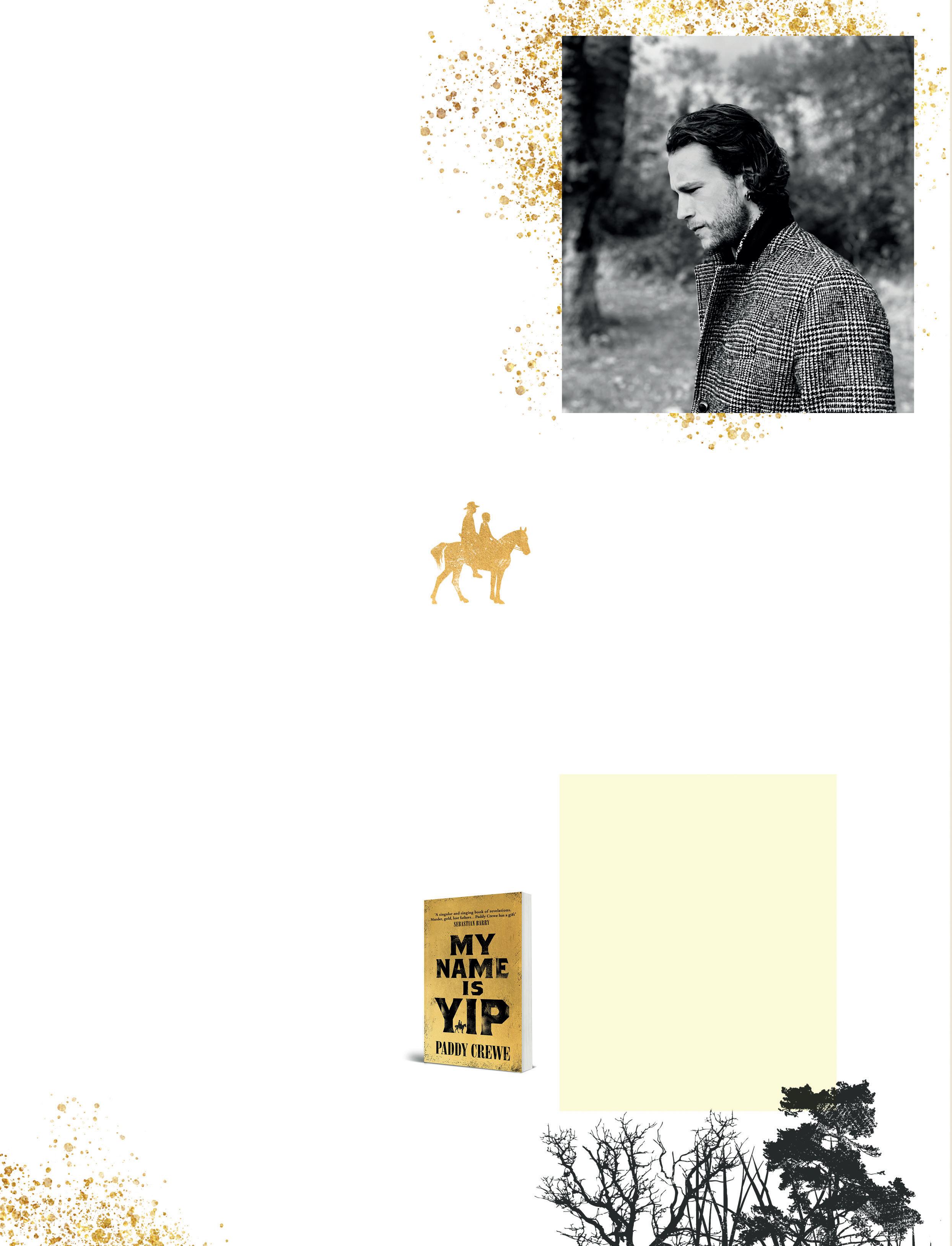
My Name is Yip is out now.
misunderstanding; Yip both seeks her love and repels it. Ellen is strong, independent, fearless; and yet she is incredibly lonely, frustrated, lost, unsure how to raise a child under such difficult circumstances. Her love for her child is no less than any other mother’s, but it so often fails to take a true, honest form. Their relationship is the engine of the book.
If you were to ask Yip if he were an underdog or a hero, I’m pretty sure he’d write that he was neither. I certainly didn’t set out to write a book about one or the other. I think he is who he is, and he does the best he can in some very testing times. I think he shows great courage and mettle, but he’s also deeply flawed.”
ABOUT THE BOOK
Georgia, 1815. One October night, Yip Tolroy is born, the cord snaked around his fragile neck, his skin a deathly white. Fifteen years later, and Yip still has not spoken a word – he is mute, friendless, an outcast. But his life is about to change irrevocably. Gold is discovered nearby, and Yip commits a grievous crime that leaves him with no choice but to flee. In the company of a new and unlikely comrade, Dud Carter, Yip must take to the road, embarking on a journey that will thrust him unwittingly into a world of menace and violence, of lust and revenge.
THIS MONTH’S TOP FICTION
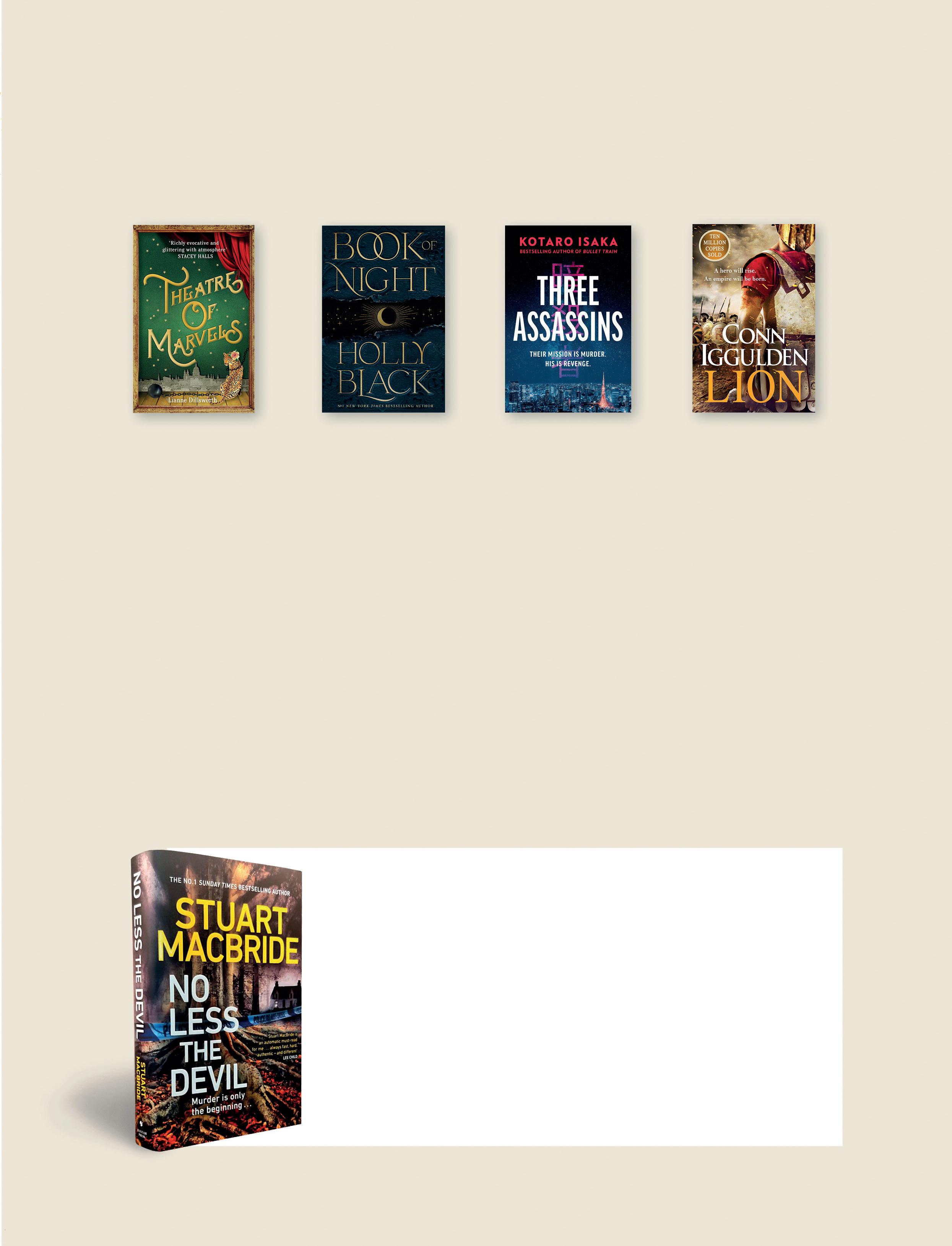
Theatre of Marvels
by Lianne Dillsworth
Crowds gather at Crillick’s Variety Theatre, where curiosity is satisfied with displays of intrigue and fear. They’re here for the star of the show – the Great Amazonia warrior. They needn’t know this warrior is in fact Zillah, a mixed-race actress from the East End fooling them each night with her thrilling performance.
Then Crillick’s new act goes missing, and Zillah feels compelled to investigate. An immersive debut.
Book of Night by
Holly Black
Charlie Hall has never found a lock she couldn’t pick, a book she couldn’t steal, or a bad decision she wouldn’t make. She’s spent half her life working for gloamists, magicians who manipulate shadows to peer into locked rooms, at strangle people in their beds, or worse. Gloamists guard their secrets, creating an underground economy of grimoires. And to rob their fellow magicians, they need Charlie. A modern fantasy of shadowy thieves and secret societies.
Three Assassins by Kotaro Isaka
Suzuki is an ordinary man until his wife is murdered. When he discovers the criminal gang responsible, he leaves behind his life as a maths teacher and joins them, looking for a chance to take his revenge. What he doesn’t realise is that he’s about to get drawn into a web of unusual professional assassins, each with their own agenda, like the Whale who convinces his victims to take their own lives using just his words. A propulsive thriller.
No Less the Devil by Stuart MacBride
Lion by
Conn Iggulden
After the Myths and Legends came the world of Men. In their front rank stood Pericles. The Lion of the Golden Age. Experience the epic battlefields of Ancient Greece with the master storyteller Conn Iggulden. Discover the rise and fall of the world's greatest empire in the stunning first instalment of The Golden Age, an epic new series from one of the world's finest historical novelist. Vivid, gritty and full of political intrigue.
It’s been seventeen months since the Bloodsmith butchered their first victim and Operation Maypole is still no nearer to catching him. Now isn’t the time to get distracted with other cases, but Detective Sergeant Lucy McVeigh doesn’t have much choice: after 16 years in prison for hunting down and killing a homeless man, 27-year-old Benedict Strachan is back on the streets, convinced a shadowy ‘They’ are out to get him – and begging Lucy for help. It sounds like paranoia, but what if he really is caught up in something bigger and darker than Lucy’s ever dealt with before? Chilling, compulsive and threaded with dark humour.
‘Stuart MacBride is an automatic must-read for me... always fast, hard, authentic - and different.’ - LEE CHILD

Chisoni
by J.G. Jesman
Following his brother’s funeral, Chisoni embarks on a flight to England, where he lives. In his pocket is a note to their father, written by his brother shortly before his death. Chisoni cannot bring himself to look at the note, let alone deliver it. His neighbour on the plane is a loquacious Irishman and, over the course of their 13-hour flight, the two form a genuine connection, sharing their thoughts and fears about life and death. This honest account of grief is both thought-provoking and humorous.
Tenk deur Pieter
Stoffberg
1987. ’n Konvooi vegvoertuie is op pad na Angola om oorlog te maak. Vir die eerste keer is Suid-Afrikaanse tenks deel van die opmars om die Rooi Gevaar te stuit. Kommandant Leon Marais dra nie net die las as bevelvoerder nie, maar bots ook met sy direkte hoof. Dit is van die grootste veldslae met Suid-Afrikaanse tenks in Angola. Daar is soldate wat sterf en vermink word. Ander breek onder die spanning. Almal keer terug met wonde in hul gemoed. 'n Klinkende stuk van historiese fiksie.
Breathless by Amy McCulloch
Struggling journalist Cecily Wong is delighted to be invited to interview famed mountaineer Charles McVeigh, conditional on joining his team on one of the Himalayas’ toughest peaks. But on the mountain, it’s clear something is wrong. It begins small – a theft, an accidental fall. And then a note, pinned to her tent in the night: there’s a murderer on the mountain ... A highconcept thriller from a uniquely experienced author, being an expert mountaineer herself.
Yinka, Where is Your Huzband?
by Lizzia Damilola Blackburn
Yinka wants to find love. Her mum wants to find it for her. She also has too many aunties who frequently pray for her delivery from singledom, a preference for chicken and chips over traditional Nigerian food, and a bum she’s sure is far too small as a result. Oh, and the fact that she’s a 31-yearold South-Londoner who doesn’t believe in sex before marriage is a bit of an obstacle, too ... Riotously funny and full of heart, Yinka is the heroine we’ve all been waiting for.
Book Lovers by Emily Henry
Nora is a cut-throat literary agent at the top of her game. Her whole life is books. Charlie is an editor with a gift for creating bestsellers. And he’s Nora’s work nemesis. After some convincing, Nora’s sister persuades her to swap her desk in the city for a month’s holiday in Sunshine Falls, North Carolina. It’s a small town straight out of a romance novel, but instead of meeting sexy lumberjacks, handsome doctors or cute bartenders, Nora keeps bumping into ... Charlie. A hilarious enemies-to-lovers rom-com.
‘A razor-sharp and modern book, featuring a fierce heroine who does not apologise for her ambition and heartfelt discussions of grief.’ - TAYLOR JENKINS REID, AUTHOR OF MALIBU RISING
“Ihave spent a significant proportion of my life on buses, trains and the London Underground. I often saw the same faces and, like Iona, I would make up nicknames for my fellow commuters, and imagine what their lives away from our shared journey must be like. That was how my passion for storytelling began.
I never spoke to any of these people. Nor did anyone speak to me. That would have been weird. I once saw the face of a very smartly dressed man on the Underground begin to turn green. We all looked at him askance, until eventually he put his expensive leather briefcase on his knee, opened it up and vomited into it. He then closed it again and got off at the next stop. Nobody said a word. That’s what it’s like to be a Londoner.
Every so often I would read stories in the Evening Standard about men who would commute in a suit to central London for months after losing their jobs, because they were too ashamed to tell anyone, even themselves, the truth. I was fascinated by these stories, and wondered what would make someone behave like that. That question lodged in my subconscious and eventually became Piers.
I grew up in a house by the River Thames in East Molesey. The house, in fact, that Iona lives in. I described that house from my memories of the 1980s, so I apologise to the current owners who have, no doubt, extended and modernised it. Every day, my dad took the
Strangers on a Train
A daily train commute sparks unlikely friendship in Clare Pooley’s brand-new feel-good novel. What would have happened if I’d ignored the unwritten rule of commuting and had been brave enough to talk to my fellow passengers?
train to work from Hampton Court to Waterloo and, when I was a teenager, I took the same line to school in Wimbledon. I remember a particularly nasty gang of girls from a rival school who would ridicule me for always having my head in a book. That memory, along with my adolescent crush on David Attenborough, inspired Martha.
I also need to beg forgiveness from anyone who currently commutes on the Hampton Court to Waterloo line. You’ll have noticed that I took some liberties with, as Iona would say, the actualité. The train usually leaves from Platform 3 at Waterloo, but Platform 5 just rolled off the tongue a little more neatly. Also, at some point over the last decade, the layout of the trains was reworked to remove all the tables. Iona would have been horrified! Where would she put her cup of tea and her papers? Luckily, the joy of fiction is that it’s enabled me to correct this egregious error of South Western Railway.
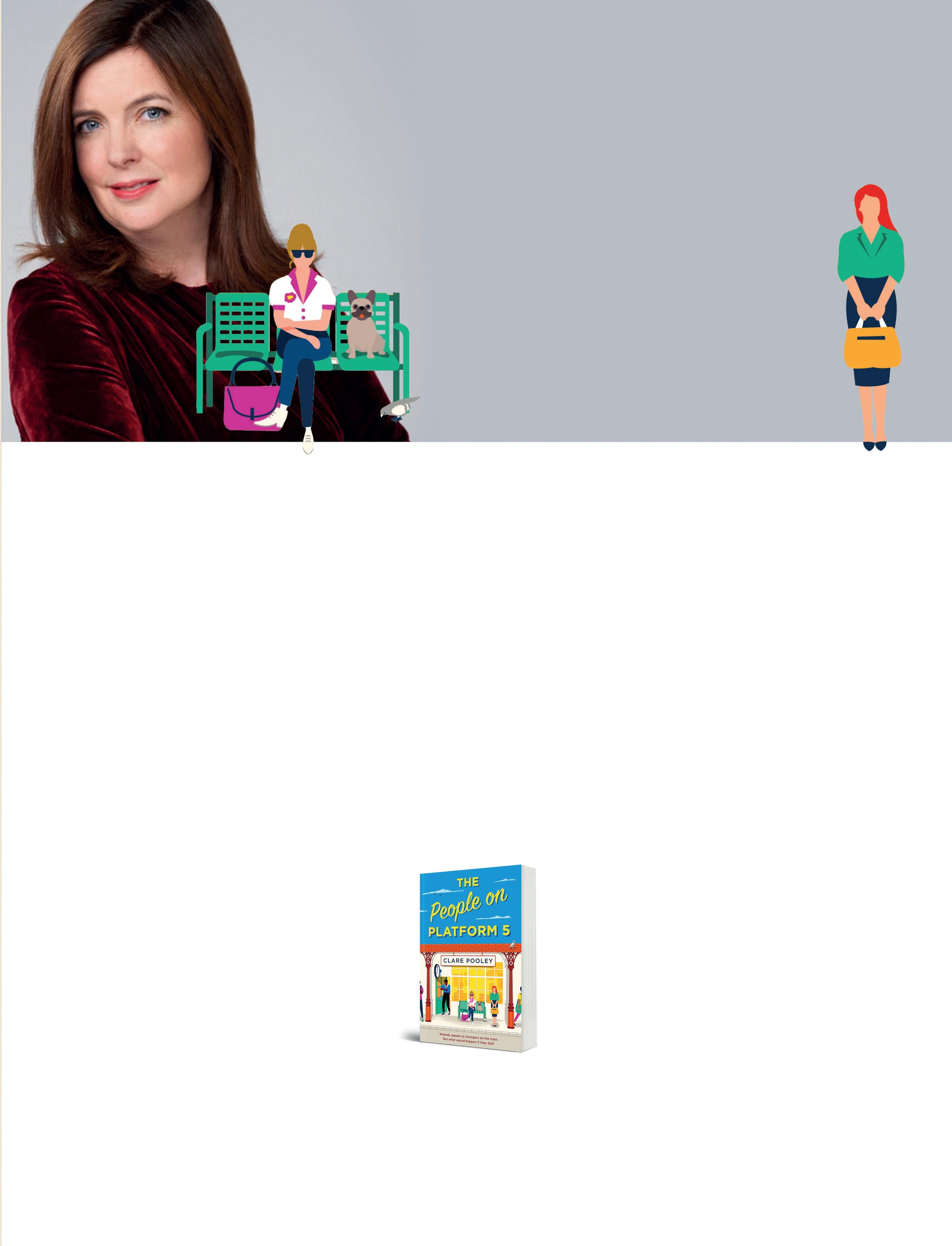
The People on Platform 5 is out now
Now I work from home and in libraries and cafés, and I never expected to miss those days of crowding into dirty, smelly railway carriages. But then, the pandemic hit, and I found myself looking back on those times with an incredible sense of nostalgia. I also started to wonder what would have happened if I’d ignored the unwritten rule of commuting and had been brave enough to talk to my fellow passengers. What adventures might those conversations have taken me on?
And that thought became this book.”
CREATING REAL EXPERIENCES
It’s impossible to develop a character with depth and vulnerability without drawing on your own experiences, thoughts and, yes, moods, says Andrew Brown, of his serial character, Captain Eberard Februarie.
‘Idon’t think Eberard Februarie would say that.’
‘He’ll say whatever I tell him to say,’ I respond hotly to my editor. ‘I created him, I molded him from the great emptiness when he wasn’t even a twinkle in my literary eye. He’ll do what I say. I can make him do terrible things, I can punish him with celibacy, deprive him of his brandy, make him vegetarian. Hell, I could make him come out!’
Of course I say none of these things. I’m much too intimidated by my editor. Instead I meekly say, ‘Yes, of course,’ and click Accept on the word processor.
But the simple editorial comment does raise a complex aspect of writing fiction, particularly where a serial character is involved. You are not your character; your character is not you. Yet, so much of you as a writer is in the characterisation. It’s impossible to develop a character with depth and vulnerability without drawing on your own experiences, thoughts and, yes, moods.
Writing is a moody affair. And it’s a strong author who will allow their character to roam freely and happy, while they are personally experiencing neither joviality nor much elation. The blacker one’s mood, the more dire the poor character’s challenges are likely to be.
But naturally that’s only my perception. Michiel Heyns told me he wrote The Reluctant Passenger, one of the funniest books I have read, at the most difficult time in his life. I immediately reread it, looking for tell-tale signs, but found few. It is an extraordinary gift to be able to write with such freedom.
I have always struggled to separate myself
Why should Eberard galivant about the Cape solving crime and receiving accolades, when I was stuck in some purgatorial trial?

The Heist Men is out now.
from my characters. Deon Meyer says that there are times when he lies awake worrying whether Benny Griessel is happy. It’s noteworthy that with the last few Griessel novels, Benny’s lovelife has improved incrementally as his waistline has reduced by a similar factor. Deon has clearly decided it’s time to give his long-suffering detective, and himself, a break from adversity.
And so I thought perhaps, this time around, Eberard could experience a greater lightness of being. I made a conscious effort in The Heist Men to improve his lot: I gave him a promotion, some friends, even a love interest. The drinking slowed (a little) and his relationship with his daughter strengthened (somewhat). It went well initially, swimmingly in fact. I quite enjoyed giving the embattled policeman a dose of good fortune.
But then, mid-manuscript, I had the misfortune of spending the entire day sitting at the Parow Regional Court, waiting to give evidence as the arresting officer in a child abuse case. While sitting on a rock-hard bench, sipping warm water and trying to keep my palms off the sticky seat, my son messaged to tell me my geyser had burst. Then, I got a message from SARS … and resentment started to fester.
Why should Eberard galivant about, solving crime and earning accolades, when I was stuck in some purgatorial trial? This swanning around would have to stop. After all, crime thrillers are meant to portray the gritty truth of our reality. And my reality in that moment was gangsters, grubby floors and the smell of urine wafting down the hallway. I resisted the urge to have Eberard’s own geyser flood his bedroom with scaling hot water. But I confess, things took a nasty turn for him from there.”
MEET THE WOMEN’S MURDER CLUB
The stars of James Patterson’s hit mystery series.
THE REPORTER CINDY THOMAS
Meet Cindy Thomas, pretty, blonde and city cool. She’s a crime desk reporter for the San Francisco Chronicle. Cindy is a graduate of the University of Michigan where she was a sociology major. She loves yoga, jazz and reading travel books and mysteries – she’s even a member of a book club. She has a tattoo of two small G-clefs on her shoulder.

THE DETECTIVE LINDSAY BOXER
Meet Lindsay Boxer, a homicide detective for the San Francisco Police Department. She was a sociology major and graduated from San Francisco State (to which she transferred from Berkeley when she found out that her mother had breast cancer). She loves beer and butterscotch praline ice cream. She has a border collie named Martha. She enjoys running, loves to read travel books and mysteries and her secret hobby is tai chi. Lindsay has been divorced once and is now married to Joseph Molinari. She has a younger sister named Cat and a father named Marty, who was also a member of the SFPD. Marty left Lindsay’s mother when Lindsay was 13. One thing that very few people know about Lindsay is that she has a tattoo of a gecko on her left buttock.
THE MEDICAL EXAMINER
CLAIRE WASHBURN
Claire often jokes, “I’m in shape ... round’s a shape.” Claire is wise, confident, kind, and married to Edmund, a kettle drum-player in the San Francisco Symphony Orchestra. Claire and Edmund have two teenage sons and a young daughter named Ruby Rose. Her tattoo: an outline of a butterfly just below her waist. She also goes by the nickname “Butterfly”.
THE DISTRICT ATTORNEY
YUKI CASTELLANO
Yuki is ambitious, passionate and brilliant, given to speaking at 90 miles per hour, and sometimes wears a magenta red streak in her black, shoulderlength hair. Her mother is Japanese and her father Italian American. Yuki’s favourite drink, when out with the other members of the Club, is a Germain-Robin sidecar.
THE LATEST BOOK IN THE SERIES
22 Seconds by James Patterson & Maxine Paetro
SFPD Sergeant Lindsay Boxer has guns on her mind. There’s word of a last-ditch shipment of drugs and weapons crossing the Mexican border ahead of new restrictive gun laws. Before Lindsay can act, her top informant tips her to a case that hits disturbingly close to home. Former cops. Professional hits. All with the same warning scrawled on their bodies: You talk, you die. Now it’s Lindsay’s turn to choose.
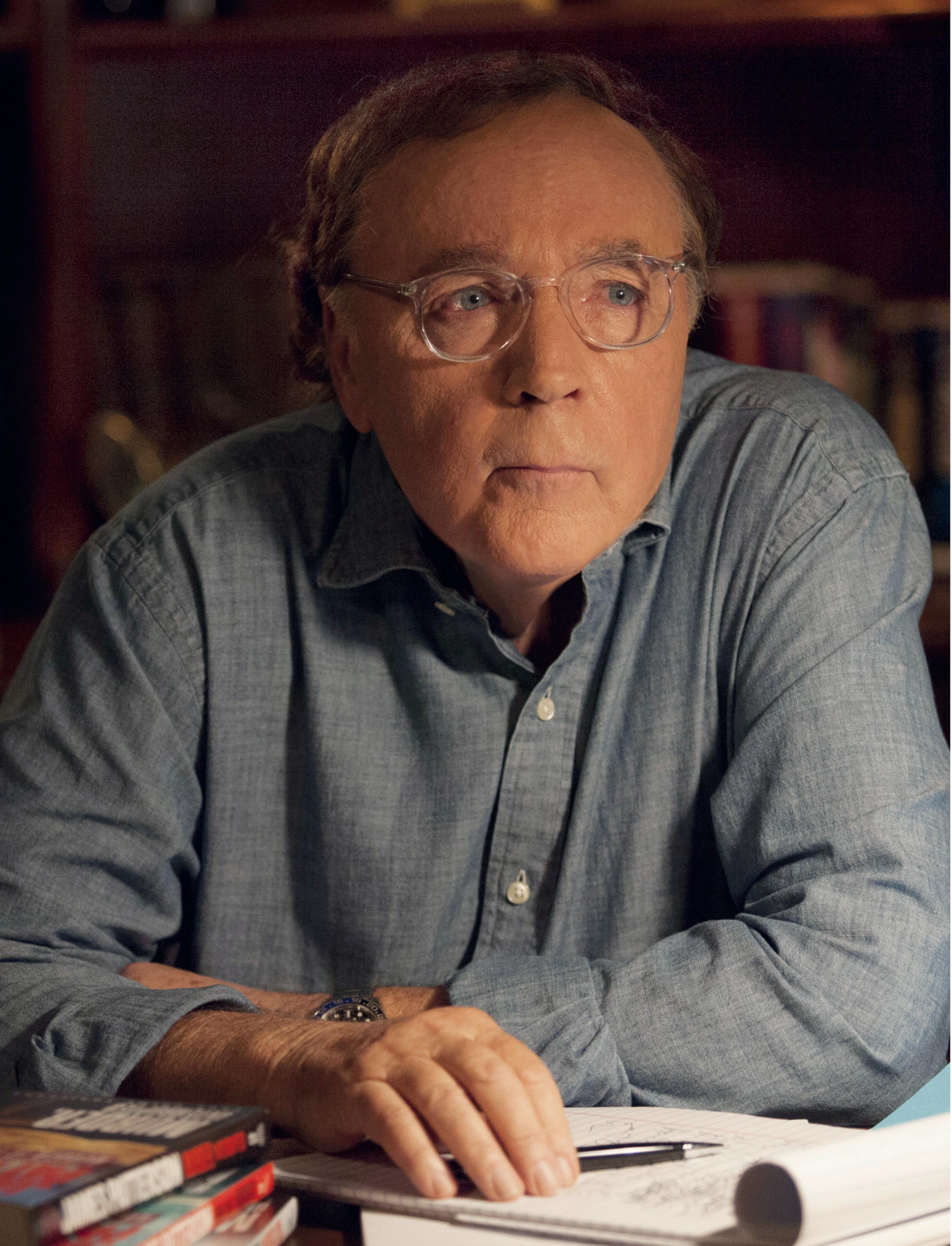
FIVE
YEARS AT A CUCKOO’S NEST
How did a boy from small-town New York become one of the world’s most successful writers? In this extract from his official autobiography, James Patterson writes how his career as a writer began inside a psychiatric hospital.
“My writing career unofficially began at McLean Hospital, the psychiatric affiliate of Harvard Medical School in Belmont, Massachusetts. It was the summer of 1965 and I was eighteen. Fresh out of high school. I needed a job, any job, and McLean was hiring. I spent a good part of the next five years at this mental hospital. That’s where everything changed about how I saw the world and probably how I saw myself.
I wasn’t a patient. I swear. Not that I have anything but the highest regard for mental patients. I just wasn’t one of them. Besides, back then I couldn’t have afforded a room at McLean, not even space in a double room.
I was a psych aide. I think I was hired because I have empathy for people. You’ll be the judge of that. The heart of the job was to talk to patients and, more important, to listen to them. Occasionally, patients tried to hurt themselves. My job was to try and stop that from happening. In addition to my usual daytime shift, I worked two or three overnight shifts a week, from eleven p.m. until seven in the morning. Most nights I just had to watch people sleep. Which isn’t that easy.
I had never liked coffee, but I started drinking the awful stuff just to make sure I stayed awake, since there were usually
I started reading like a man possessed during those long, dark nights of other people’s souls.
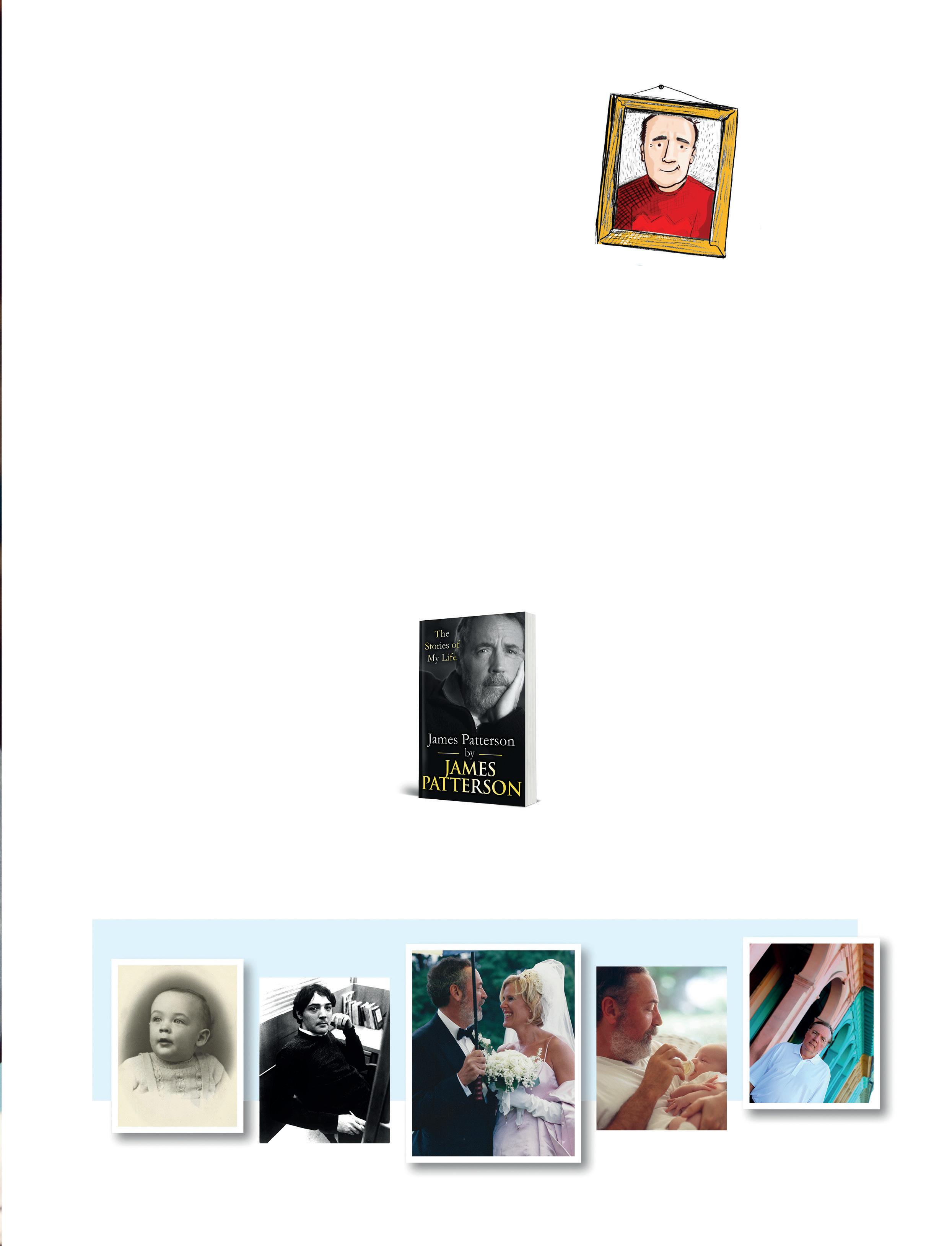
James
Patterson: The Stories of my Life is out now.
patients on suicide watch at Bowditch or East House in the maximum-security wards where I regularly worked. For hourlong stints I had to sit outside their rooms, watching them flop around in bed, listening to them snore, while I fought off sleep at three or four in the morning.
So I had a lot of free time. I started reading like a man possessed during those long, dark nights of other people’s souls.
Two or three times a week, I’d go the three miles or so into Cambridge and make the rounds of the second-hand bookstores.
I especially loved tattered, dog-eared books. Books that had been well loved and showed it. The used books cost me a quarter, occasionally a buck, even for thick novels like The Sot-Weed Factor, The Golden Notebook, The Tin Drum.
At the time, I wasn’t interested in genre fiction, the kind of accessible stuff I write. I had no idea what books were on the New York Times bestseller lists. I was a full-blown, know-it-all literary snob — who didn’t really know what the hell he was talking about.
My ideas about how the world was supposed to work had been framed growing up in Newburgh, New York, and the somewhat parochial outer reaches of Orange County. As I read novel after novel, play after play, my view of what was possible in life began to change.”
JAMES PATTERSON A TIMELINE
Born in 1947
Our wedding day
Feeding Jack
In Cuba
At J. Walter Thompson ad agency
“TELEPHONES WERE JUST NOT REGARDED AS A PRIORITY BY THE COMMUNISTS.”
Poland in the 1970s was a bit like George Orwell’s Animal Farm: the only people who had more than others were members of the communist party, writes prolific Polish-South African businesswoman, Magda Wierzycka, in an extract from her memoir.
“Igrew up in communist Poland. Ostensibly ruled by the communist Polish United Workers’ Party as a semi-independent satellite state in the Eastern Bloc, true power rested with the Soviet Union, which had installed the government after World War II. On many levels it was a simple political system: the ruling party, allied with the Soviets, exercised complete control over all aspects of one’s life, including freedom of movement, while swamping the country with pro-communist and pro-Soviet propaganda. In exchange, they guaranteed everyone free healthcare and education, and full employment. No one had much, but most people had the same. It was a bit like George Orwell’s Animal Farm: the only people who had more than others – including houses, cars, access to ‘Western’ products and ultimately power – were members of the communist party. To put it in perspective, there were around three million registered members of the party out of a population of 36 million.
Our eighty-square-metre apartment was large by common standards. But it had to house my parents, me and my younger sister and brother, Ashka and Wojtek, and my grandmother who took care of us. The only reason we even qualified for an apartment was because my parents agreed to move from Gliwice to a newly built mining town in Upper Silesia called Jastrzębie-Zdrój. We also qualified for a telephone and a small car, a Fiat 126 nicknamed Maluch, meaning ‘the little one’. By today’s standards, it looks like a toy. The apartment and the car were luxuries
Most women regularly had their stockings mended by a stockings ladder mender, which was a popular profession.
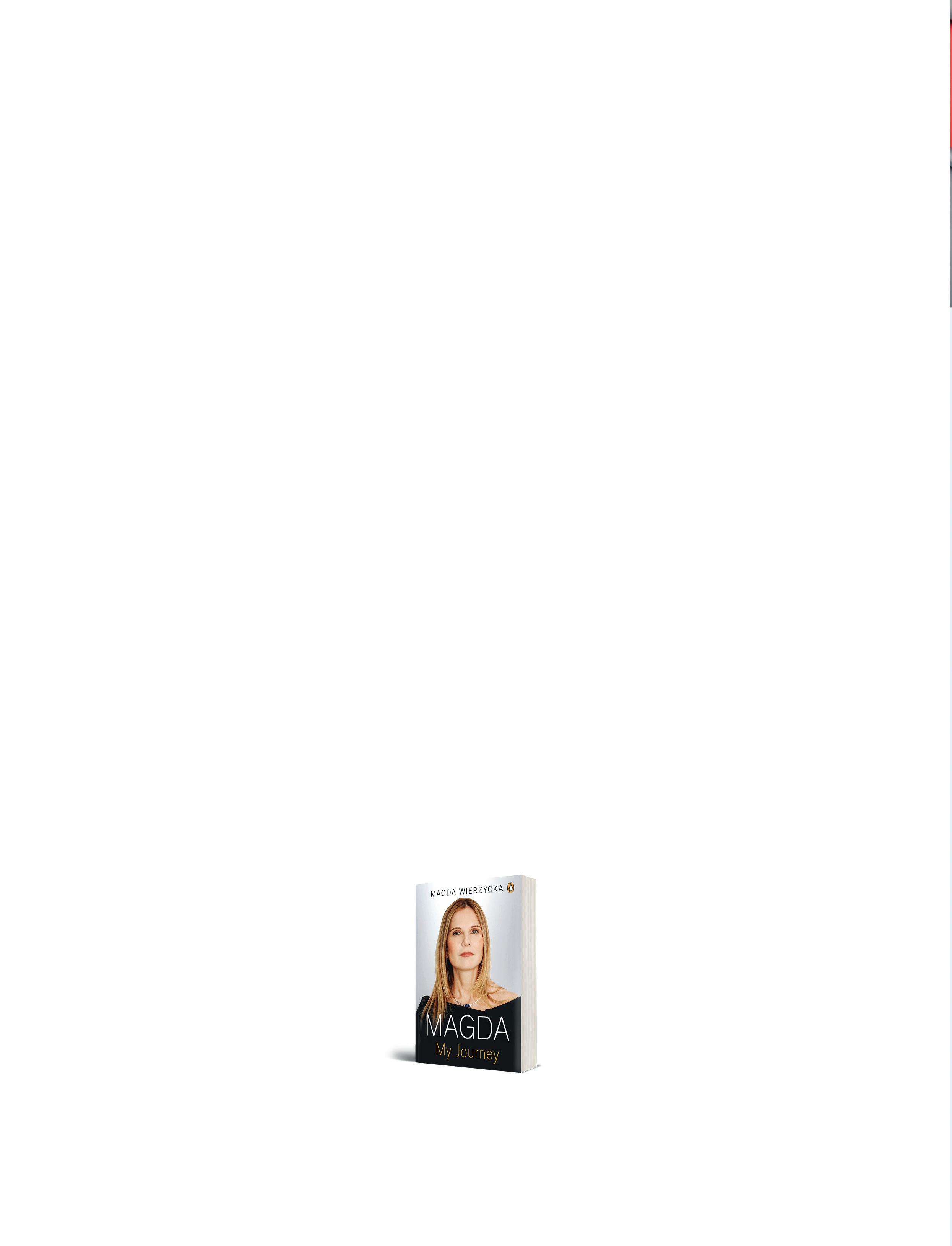
Magda: My Journey is out now.
not easily accessible to young people, who tended to live with their parents until they were allocated an apartment of their own. And telephones were just not regarded as a priority by the communists. My parents, both medical doctors, worked six days a week, and we went to school for the same six days. Saturday was not a ‘rest day’ under communism, even though a lot of people went to work with nothing to do. The closest I have come to reliving that life was watching the 2019 TV series Chernobyl. The apartment blocks were a precise match for the estates on which we lived.
We had no money for fancy holidays or clothes. Things I now take for granted – such as stockings, jeans, perfume and wine – were imported from the West and available only in the specialist Pewex stores (short for Przedsiębiorstwo Eksportu Wewnętrznego – Import Export Company) to politicians, and only then if you had access to US dollars, which most people did not, as it was forbidden to hold foreign currency in cash. As stockings were a precious commodity that could not be easily replaced, most women regularly had them mended by a stockings ladder mender, which was a popular profession.
My favourite toys were Lego blocks. To this day I don’t know how they made their way to Poland, but there they were, a collection of multicoloured bricks that enabled us to build imaginary cities and inhabit the lives of others. In those days, playing with Lego required a lot of creativity as there were no preconstructed model designs as there are today. There were just blocks of different shapes, colours and sizes. Of everything we left behind, my Lego ‘city’ was the thing I missed most.”

THE POWER OF BITTERSWEET
Leaning into a bittersweet outlook helps us turn experiences of loss and pain into beauty and growth, says Susan Cain in her new book, Bittersweet
“This book is about the melancholic direction, which I call the “bittersweet”: a tendency to states of longing, poignancy, and sorrow; an acute awareness of passing time; and a curiously piercing joy at the beauty of the world. The bittersweet is also about the recognition that light and dark, birth and death – bitter and sweet – are forever paired. “Days of honey, days of onion,” as an Arabic proverb puts it. The tragedy of life is linked inescapably with its splendor; you could tear civilization down and rebuild it from scratch, and the same dualities would rise again. Yet to fully inhabit these dualities – the dark as well as the light – is, paradoxically, the only way to transcend them. And transcending them is the ultimate point. The bittersweet is about the desire for communion, the wish to go home.
If you see yourself as a bittersweet type, it’s hard to discuss Aristotle’s question about the melancholia of the greats without sounding self-congratulatory. But the fact is that his observation has resonated across the millennia. In the fifteenth century, the philosopher Marsilio Ficino proposed that Saturn, the Roman god associated with melancholy, “has relinquished the ordinary life to Jupiter, but he claims for himself a life sequestered & divine.” The sixteenth-century artist Albrecht Dürer famously depicted Melancholy as a downcast angel surrounded by symbols of creativity, knowledge, and yearning: a polyhedron, an hourglass, a ladder ascending to the sky. The nineteenth-century poet Charles Baudelaire could “scarcely conceive of a type of beauty” in which there is no melancholy.
This romantic vision of melancholia has waxed and waned over time; most recently, it’s waned. In an influential 1918 essay, Sigmund
Extracted from Bittersweet, out now.
Freud dismissed melancholy as narcissism, and ever since, it’s disappeared into the maw of psychopathology. Mainstream psychology sees it as synonymous with clinical depression.
But Aristotle’s question never went away; it can’t. There’s some mysterious property in melancholy, something essential. Plato had it, and so did Jalal al-Din Rumi, so did Charles Darwin, Abraham Lincoln, Maya Angelou, Nina Simone … Leonard Cohen.
But what, exactly, did they have?
I’ve spent years researching this question, following a centuries-old trail laid by artists, writers, contemplatives, and wisdom traditions from all over the world. This path also led me to the work of contemporary psychologists, scientists, and even management researchers (who have discovered some of the unique strengths of melancholic business leaders and creatives, and the best ways to tap them). And I’ve concluded that bittersweetness is not, as we tend to think, just a momentary feeling or event. It’s also a quiet force, a way of being, a storied tradition – as dramatically overlooked as it is brimming with human potential. It’s an authentic and elevating response to the problem of being alive in a deeply flawed yet stubbornly beautiful world.
Most of all, bittersweetness shows us how to respond to pain: by acknowledging it, and attempting to turn it into art, the way the musicians do, or healing, or innovation, or anything else that nourishes the soul. If we don’t transform our sorrows and longings, we can end up inflicting them on others via abuse, domination, neglect. But if we realize that all humans know – or will know – loss and suffering, we can turn toward each other.
This idea – of transforming pain into creativity, transcendence, and love – is the heart of this book.”
GOOD VIBRATIONS
Books to help you navigate the potholes of modern living, and an extract from Don't Worry, by the renowned Zen Buddhist, Shunmyō Masuno.
“Once we acquire things, it can be difficult to part with them.
All of us can relate to this sentiment, to a greater or lesser extent. In fact, it may even become a source of distress.
I often hear people say, ‘My home is too cramped. I don’t know when I got so many things.’ Just after you move in, your home is neat and tidy and it seems like there is plenty of room to live comfortably, but before you know it, the place is filled with things and it’s anything but a relaxing space ...
This has a depressive effect. I’m not talking about hoarders who live in ‘garbage mansions’, but I think everyone has more than a little experience with this.
The cause is strikingly obvious.
It’s due to an inability to part with things, an unwillingness to throw things away.
In Zen, we have a word for alms-giving: kisha. It means gladly giving something up, without regret. This is how we describe it when you toss coins when visiting a temple or shrine. Why would anyone be glad to give up something as important as money?
The reason is that by getting rid of things, we give up some of our own attachments.
Since attachments are likely to cloud our minds, letting go of attachments has the power to make us feel happy.
This also applies to things. Take a quick look at the things that surround you. Is there clothing stuffed in the closet or dresser that you haven’t worn in years? Do you have bags that you used once or twice or various trinkets taking up precious space?
‘I’ll use this someday ...’
This is always the excuse used to justify keeping something around. But if you haven’t even thought about it in the last three years, do you really believe that the impetus to use it will come around soon? Will you ever again use a bag that hasn’t seen the light of day in five years? The answer is most likely ‘no’.
If this sounds familiar, you must let go of your feelings and dare to get rid of things.
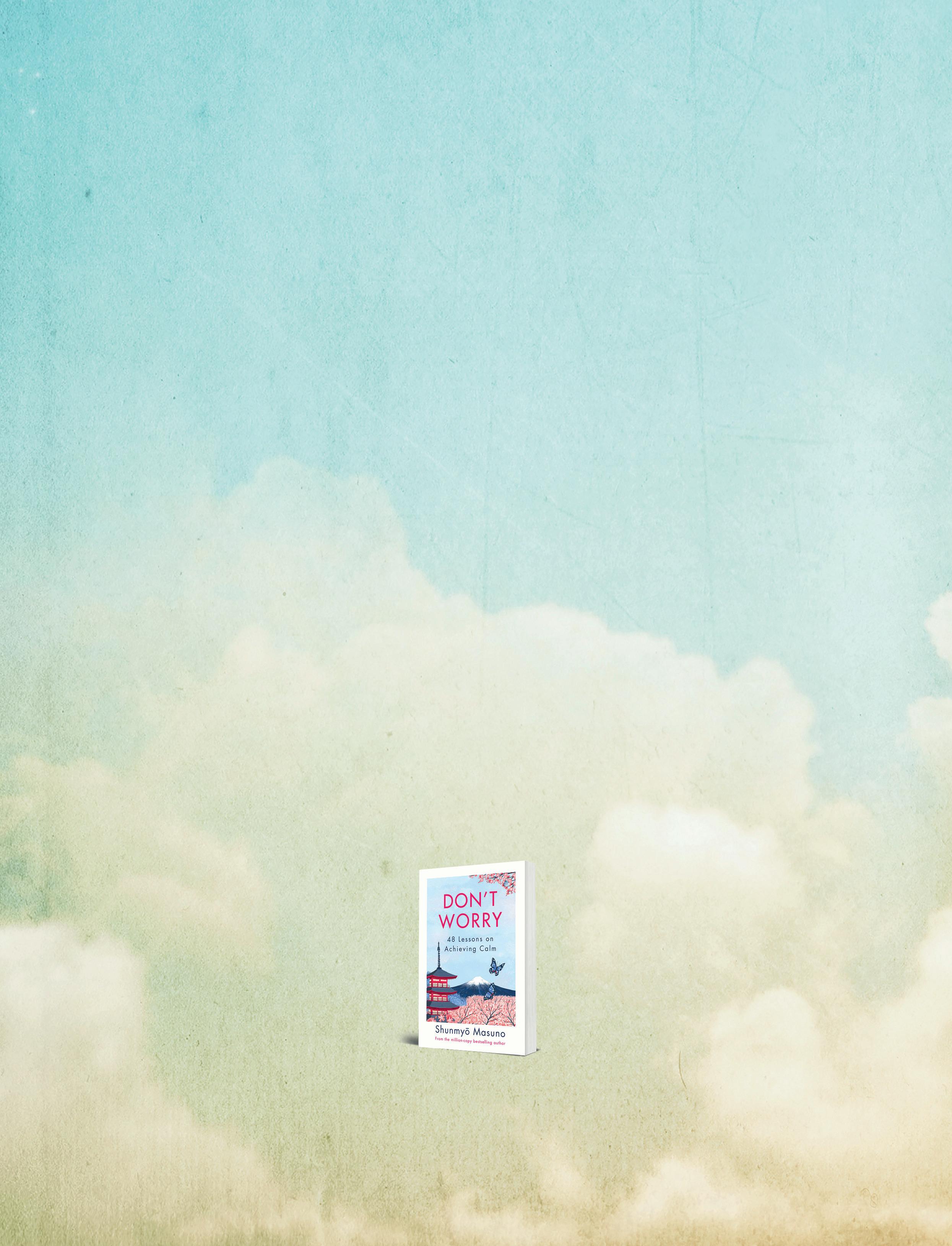
I recognise this may conflict with the mentality of not letting things go to waste.
It’s true – it can seem wasteful to cast things aside. But it’s a question of how you go about getting rid of them.
If a friend or someone you know might wear it or be able to use it, you can give it to them, or donate it to a charitable organisation. Another place to dispose of it is a flea market.
Any of these options aligns with the mentality of not letting things go to waste while still holding true to the kisha spirit of alms-giving.
Disposing of things that you ought to get rid of will create more space, which will increase the comfort of your home and improve your daily life. Needless to say, this will have a positive effect on both your physical and mental wellbeing.
Some items ought to be kept – things that cannot be thrown away, regardless of whether you use them. These include keepsakes and mementos inherited from parents and grandparents, and items you bought specifically for the family or to commemorate something special.
The challenge lies in determining what falls into which category.
To my mind, the most important factor is how you feel about each thing.
When you hold it in your hand, does it stir up memories and warm your heart? Does it remind you of the person who gave it to you and make you happy? Does it make you feel relieved or invigorated?
This has nothing to do with monetary value. There are some things worth keeping, no matter how old and tattered they are, even if they’re broken. These items are much more than simply ‘things’ – they are intimately connected with your life. Find a beautiful box where you can tuck these tokens away and save them.
In Zen, we speak of ‘walking hand-in-hand’.
This means going through life with those in whom we truly believe and trust – including our essential selves. The things that enable us to safeguard our memories are in no small part responsible for this feeling as well.”
Extracted from Don’t Worry by Shunmyo Masuno, out now.

The Book of Joy by Dalai Lama & Desmond Tutu
Archbishop Desmond Tutu and the Dalai Lama have been friends for many, many years. Between them, they have endured exile, violence and oppression. And in the face of these hardships, they have continued to radiate compassion, humour and above all, joy. This book is a gift from two of the most important spiritual figures of our time. Full of love, warmth and hope, The Book of Joy offers us the chance to experience their journey from first embrace to final goodbye.
Why We Sleep by Matthew Walker
Sleep is one of the most important aspects of our life, health and longevity and yet it is increasingly neglected in twenty-firstcentury society, with devastating consequences: every major disease in the developed world – Alzheimer’s, cancer, obesity, diabetes – has very strong links to deficient sleep. In this book, the first of its kind written by a scientific expert, Professor Matthew Walker explores twenty years of cutting-edge research to solve the mystery of why sleep matters.
You Can Heal Your Life by Louise Hay
Louise L. Hay, bestselling author, is an internationally known leader in the self-help field. Her key message is: “If we are willing to do the mental work, almost anything can be healed.” The author has a great deal of experience and firsthand information to share about healing, including how she cured herself after being diagnosed with cancer. As Hay says in the book, “The thoughts we think and the words we speak create our experiences.”
Ask and It is Given by Jerry Hicks
Pairing empowering channelled teachings with practical guidance on the Law of Attraction, this book will help you to manifest a joyful and fulfilling life. This book explains how our relationships, health issues, finances, career concerns and more are influenced by the Universal laws that govern our time/space reality and describes powerful processes that will help you manifest your desires and live the life you deserve. Esther and Jerry Hicks’ first book presenting the teachings of the non-physical entity.
Women Who Run with The Wolves
by Clarissa Pinkola Estés
In this classic, Dr Estés tells us about the ‘wild woman’, the wise and ageless presence in the female psyche that gives women their creativity, energy and power. For centuries, the ‘wild woman’ has been repressed by a male-orientated value system that trivialises women’s emotions. Using a combination of time-honoured stories and contemporary casework, Estés reveals that the ‘wild woman’ in us is innately healthy, passionate and wise. Thoughtfully written and compelling, the book offers readers a new sense of direction, a self-confidence and purpose in their lives.
ACHIEVING FINANCIAL LONGEVITY
With average life expectancy increasing by the day, living longer challenges the traditional mindset of a retirement date being a line drawn in the sand. Financial planner, Wynand Gouws, gives advice on how to provide for yourself should you live to a ripe old age.
“The list of people living well into their 90s and beyond 100 is growing by the day. People are living longer. But not only that; the traditional definition of retirement is being redefined. People are living longer, productive and happy lives after 65, well into retirement.
In To 100 & Beyond, I share practical examples of how people are redefining retirement and reimagining their life plans to make the most of life to age 100. Many are completely revising the notion that you should be retiring and slowing down from age 65. The realisation that they might live to 100 means that people need to make sure they have the financial ability to continue living a fulfilled life, but also that they need to find meaning to carry on living a happy and productive life past the traditional retirement age of 65.
It is a reality that people are living longer lives. In this book I unpack some of the data and science behind mortality and longevity and how life expectancy has rapidly increased over the past decades and continues to do so. Even though there are occasional setbacks in mortality rates, including HIV and the current Covid-19 pandemic, the long-term increase in longevity is indisputable. Life expectancy increased by 20 years over the past 50 years as a result of continued advancements in medical science, and this trend is likely to continue.
Globally we are seeing the establishment of institutions that specifically research the implications of longevity from a societal perspective. The broader impact of longevity is immense. Institutions such as the Stanford Center on Longevity in the United States and the International Longevity Centre UK
The traditional notion of retirement is outdated and needs to be redefined.

To 100 & Beyond is out now.
(ILCUK) are examples of some of the institutions leading academic thinking on the societal and personal implications of living to age 100.
In the book, I explore the implications of living to 100. I consider the probability of living beyond 90 or 100 and the importance of reframing our financial plans. Even though I focus on the financial implications of longevity, these have a wide range of knock-on effects. Irrespective of where you currently are in life, living longer fundamentally challenges our traditional conception of retirement as a specific cut-off point, as a line drawn in the sand. Data clearly show that the traditional notion of retirement is outdated and needs to be redefined through a revised financial plan that takes account of the probability that we can all live to 100. Once you have your financial plan, you can start working on a revised financial roadmap for life to 100.
To help you do this, I share some financial principles in the book – the kind of stuff I wish my dad had taught me, and the information I strongly believe should be included in the South African education curriculum to enable young people to start early with planning for their life to 100. Throughout the book I share practical examples to bring these principles to life.
My aim is to help you rethink your lifetimeframework by providing practical financial planning tools and guidance on topics that range from how to start out, to considering alternative accommodation in your 80s and beyond, to being tax- and investment-smart throughout your life.
My hope is that this book will provide you with an opportunity to rethink your life and find some guiding principles and ideas that might help you develop your revised life plan for a longer life that is financially secure.”
A MILLION MILES AWAY
The Universe is the one thing that unifies us here on earth, writes astronomer Auke Slotegraaf.
“There’s just something about the Universe that is utterly appealing. It’s not that it’s the biggest thing we know of, nor that it’s the oldest thing in existence. Or that we are a part of it. Or even that every person who has ever existed, has lived in it. The Universe is utterly appealing because it is beautiful.
The most beautiful part of it, I like to think, is the heaven’s above. The Sun, the Moon, the wandering planets, the twirling stars, and the short-lived sparks from a meteor, are literally (and figuratively) delightful.
The Universe has been around a long time. According to astronomers, the longest time. The best we know, based on exquisite and painstaking observations by many observers and many telescopes over decades of careful study, some 14 billion – or 14,000,000,000 –
ABOVE Solar system favourites

years ago the Universe happened.
Then, about 4,500,000,000 years ago, our solar system formed. It was built out of debris and space junk scattered about in a small section of our Milky Way galaxy. The heavyweight in our solar system is the Sun, a hot, bright star, that calls all the shots. It shines by creating light because it is an atom bomb. In just a single second, the Sun makes as much energy as 7 billion Koebergs.
Fortunately for us, this ongoing nuclear furnace is far, far away from our little planet. Roughly speaking, there is 150 million kilometres between you and our nearest star. This is a good thing. If we were much closer, the Earth’s atmosphere would vaporise, the oceans would boil away, and the continents would turn into heaps of lava. On the other hand, if we were a lot further away, the seas
ABOVE LEFT Lover's Moon
ABOVE Ribbons and Pearls
LEFT The Meerkat supermoon

would freeze and the planet would be a cold, dead ball of ice and dirt. Instead, we are in a “Goldilocks zone” – not as hot as on planet Mercury, not as cold as on Mars: it’s just right.
From our comfortable vantage point, we can look up at the sky and enjoy the spectacles in the heavens, and not only at night. During the day, you can see the Moon, if you know when to look. It could be a crescent Moon, or a fat gibbous Moon, depending on where in its orbit around the Earth our natural satellite is.
Also in the night sky are those distant firefly sparkles, twinkling mysteriously: the stars. Of course, the stars are there all the time, it’s just that during the “day” the Sun is too bright for us to see them. As the Sun sets, and the sky becomes darker, more and more stars pop into view. It’s fun trying to be first to spot the first evening star.
Quite often, though, the first “star” that becomes visible, isn’t a star at all. Following ancient custom, a bright sparkle visible around sunset, is called the “Evening Star”. There’s also a “Morning Star”, which would be the last star visible before the solar glare drowns everything out. Most of the time, this
brilliant luminary is actually the planet Venus. Sometimes called our “sister planet”, Venus is the second rock from the Sun, and is shrouded in eternal cloud that reflects sunlight pretty well. Because Venus is quite close to the Earth, and it is very reflective, it is very bright. When you see the Evening Star, the odds are you’re actually looking at Venus.
Besides Venus, the Evening Star could also be the planet Jupiter. Jupiter is the second brightest “star” in the sky, as well as being the largest planet in our solar system. Jupiter is so large, in fact, that is almost became a real star. If you use steadily-held binoculars, or even the smallest telescope, you’ll see that Jupiter is a real world: it is a round disc, with some dark markings on it, and it even has four bright moons. These moons move quickly, so your view will change from day to day. With a telescope, you can watch storms unfolding in the planet’s upper atmosphere and follow the movement of its four satellites.
Depending on the season, another likely candidate for Evening Star is actually a real star – Sirius. This is the brightest star in the night sky – as seen from Earth, of course – and
is sometimes known as the Dog Star. The ancient Egyptians adored it and used the star to predict when the river Nile would flood its banks, heralding the new fertile season.
Sirius has other more elaborate names in the detailed catalogues astronomers use, such as AKARI-FIS-V1 J0645085-164258 – but every star gazer knows it as Sirius. In isiXhosa, this star is known as iQhawe, “The Champion”, a superb name for this brilliant stellar beacon.
All cultures that have grown up on our planet, have their own names for the stars, planets, and other heavenly delights. The ancient cultures of China and the Middle East, the Greeks of days long gone, the Bushman peoples of southern Africa, and the Dutch explorers of the 17th century, speak of the stars in their own tongue. But at the end of the day, we are all looking at the same Universe. And it is beautiful.”
BELOW All eight planets of the solar system visible at dawn

The sun shines by creating light because it is an atom bomb.
SKY GUIDE AFRICA SOUTH – 2022
A practical resource for all astronomers, whether novice, amateur or professional. It covers the year’s planetary movements, predicted eclipses, meteor showers – any events and facets of the night sky that change annually. Star charts plot the evening sky for each season, facilitating the identification of stars and constellations. The guide contains a wealth of information about the Sun, Moon, planets, comets, meteors and bright stars, with photos, diagrams, charts and images. An essential handbook for all night-sky enthusiasts.
JOIN
THE STRUIK NATURE CLUB! Be the first to hear news of new releases, special editions, offers, as well as launches and author events. Plus, members stand in line to win great prizes monthly! Sign up at www.struiknatureclub.co.za

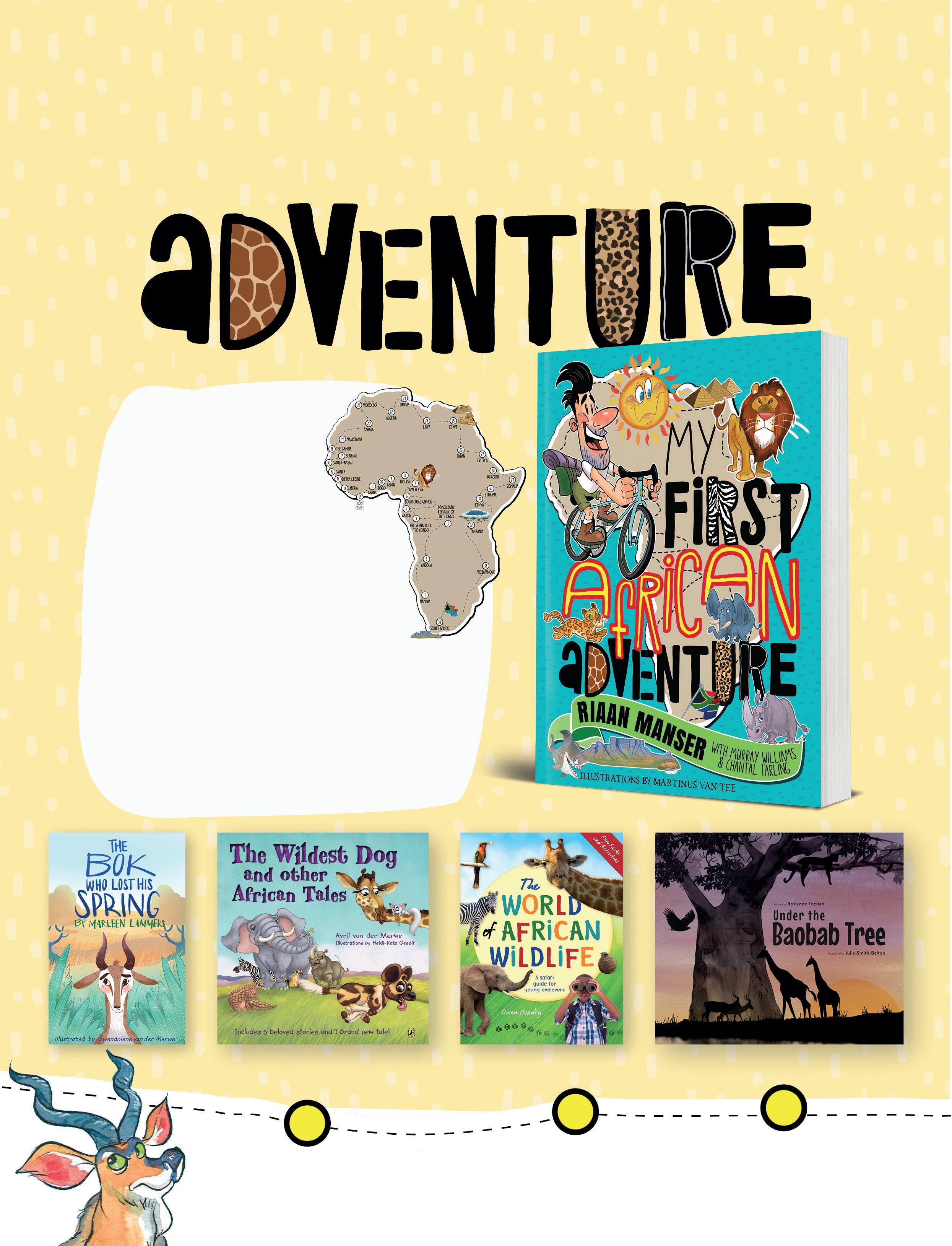
Time to Satisfy the Foodie in You
Share in the joy of making memories through food with the brand-new cookbook from Sinoyolo Sifo, also known as Sifo the Cooking Husband.
Herb-crusted Rack of Lamb
“My father’s farm in the Eastern Cape is home to a lot of sheep. When I visit, he usually slaughters one, giving me some meat to take home and cook. I usually make this rack of lamb when I return from one of these visits.”
Rack of lamb with 7–8 ribs (± 600g)
Salt and pepper, to taste
3 Tbsp (45ml) olive oil
3 garlic cloves, finely chopped
10g Italian parsley, chopped
1 Tbsp (15ml) paprika
2 sprigs fresh thyme
3 sprigs fresh rosemary
Place the rack of lamb in a roasting pan and pat dry with paper towel. Season all over with salt and pepper and set aside.
In a food processor or blender, combine the olive oil, garlic, parsley, paprika, thyme and a pinch of salt. Blend on high until thoroughly combined.
With a sharp knife, score several cuts across the fat layer on the rack of lamb. Rub the herb mixture all over the lamb, including the cuts you’ve made, so that the flavours penetrate the fat.
Cover the roasting pan with cling wrap and leave the lamb at room temperature for 2 hours.
Preheat the oven to 200°C.
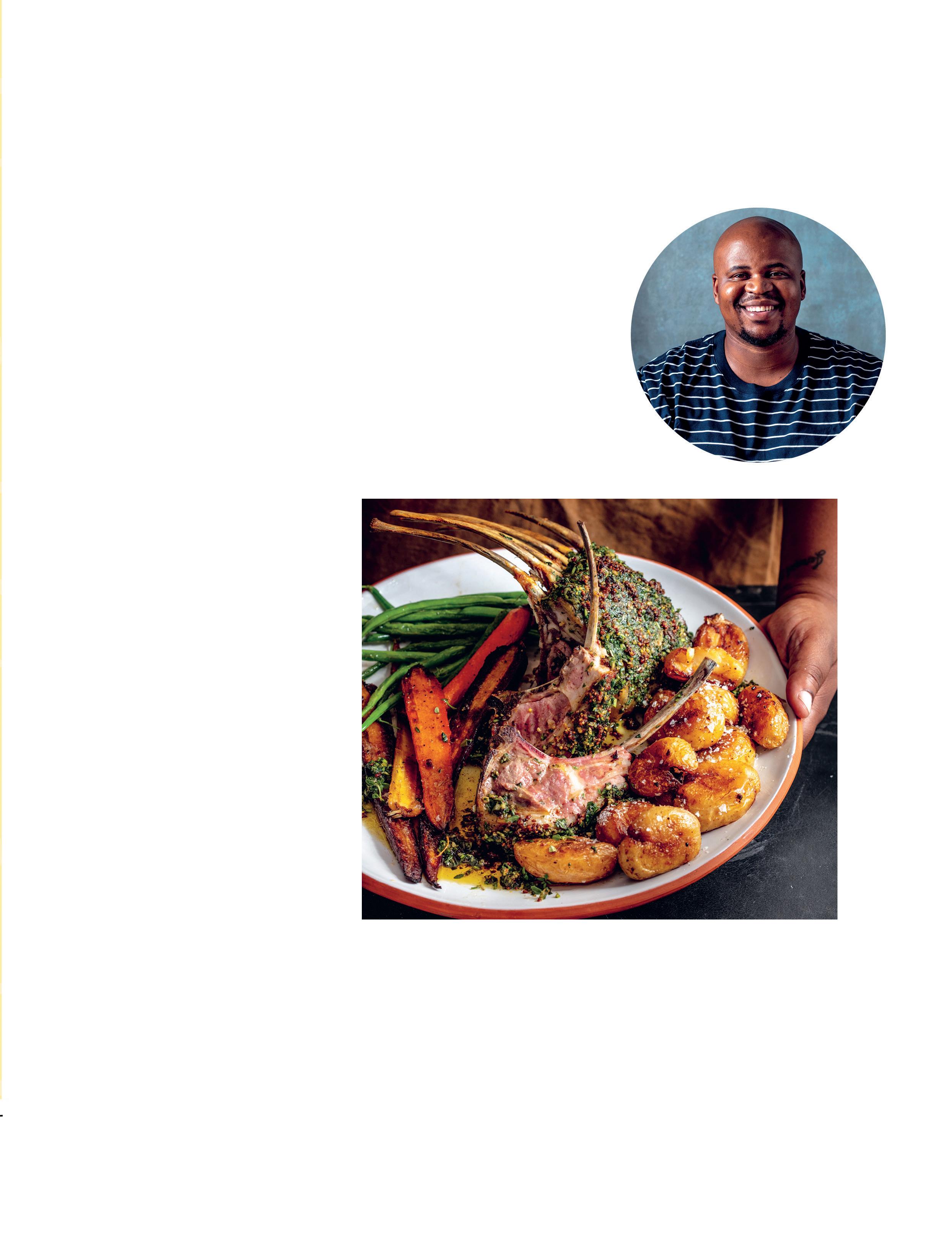
Make sure the rack of lamb is placed fat-side up. Cover the exposed rib bones with foil. Roast for 30–35 minutes for meat that is medium-rare. If you prefer your meat more welldone, roast for 40–50 minutes.
Remove the lamb from oven and remove the foil. Rest the lamb for
10–15 minutes before carving and serving.
Notes and Tips:
For a richer flavour, you can refrigerate the marinated rack of lamb overnight, but just make sure you bring it to room temperature before roasting, so it cooks evenly.
Chocolate Mousse Pie
“When I am hosting dinner at my house, this is my favourite dessert to make. The mousse has a rich chocolate flavour and very smooth texture. I usually add cream on top to balance out the sweetness.”
FOR THE PIE CRUST
1 pack (200g) Tennis biscuits
(or coconut tea biscuits)
¼ cup (60ml) butter, melted
FOR THE MOUSSE
¼ cup (60ml) butter
300g semi-sweet chocolate chips
4 egg yolks, room temperature
4 egg whites, room temperature
1 2½ Tbsp (37.5ml) brown sugar
1 cup (250ml) whipping cream, cold
1 tsp (5ml) vanilla essence chocolate shavings, to decorate
For the pie crust
Crush the biscuits until fine. You can use a food processor or place them in a plastic freezer bag and crush them with a rolling pin. Mix the butter with the crushed biscuits until a crumbly mixture forms.
Transfer the mixture to a round 23cm pie dish. Press the mixture down into the bottom and sides of the dish until compact. Set aside.
For the mousse
Fill a small pot or saucepan halfway with water and bring to a boil over high heat. Once the water has begun to boil, switch off the heat.
Chop the chocolate into small pieces and transfer to a heatproof glass or enamel bowl. Place the glass bowl of chocolate over the hot water, and allow it to rest there until the chocolate has melted, using a spatula to stir it along. To avoid burning yourself, use an oven mitt or kitchen towel to hold the hot bowl.
Stir continuously until the chocolate has cooled slightly. Stir the egg yolks into the melted chocolate.
MAKES 1 pie
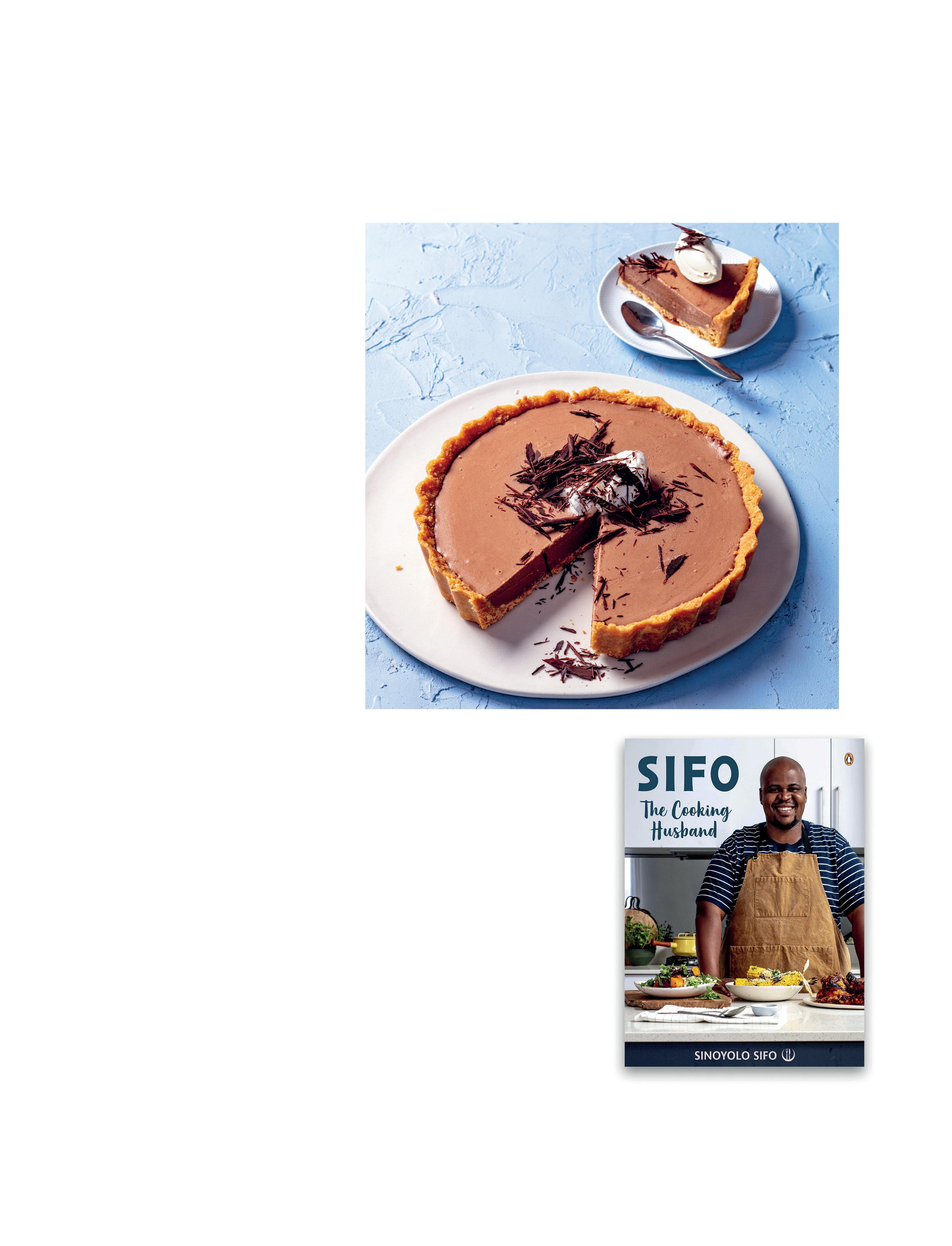
In a separate large bowl, whisk the egg whites and brown sugar until foamy and soft peaks form. Gently fold the egg whites into the melted chocolate.
In another large bowl, whip the cream until soft peaks form. Stir in vanilla essence. Fold whipped cream into chocolate mixture, but keep some cream to use as topping for the mousse pie.
Pour the chocolate mixture into the pie crust and refrigerate for at least 8 hours, or overnight.
Remove from the fridge and decorate with the remaining cream and chocolate shavings.
Sifo: The Cooking Husband is out now.
A WINE THAT REFLECTS DETAIL AND IMAGINATION
Set the table for the ultimate wine-pairing dinner with Nederburg.
“Never underestimate the power of a simple detail. It can transform even the excellent into the exceptional,” says red-winemaker, Zinaschke Steyn. “Ask anyone who treasures their craft, who works fully with their hands, heart and mind, and they will tell you the same.”
She is referring to Nederburg’s exciting new Double Barrel Reserve, a Bordeaux-style wine with a special new touch. It brings together the winery’s hallmark Cabernet Sauvignon in classic combination with Cabernet Franc, Merlot, Petit Verdot and Malbec. What makes that deliciously proportioned blend stand apart, though, lies in the detail of the maturation of its components.
“Each of the five varieties was individually vinified and that included their ageing in contact with French oak for 12 months,” explains Zinaschke. “However, the Merlot portion was taken from barrel after nine months, then blended and returned to barrel for a further three months of maturation. All components were then combined to achieve what we believe is a beautifully balanced whole. Call this double barrel process a small detail, but it delivers a significant impact. It has turned a terrifically juicy, succulent and appetising wine into one with the finest-grained silky texture and a thrilling richness and depth.
“Nose it, taste it and love it.”
Visit www.nederburg.com for more.
Biltong Spice Crusted Lamb Rump with a Chakalaka Sauce and Pap Chips
MEAT
4 x 225g lamb rump
Salt and freshly milled pepper
2 tbsp olive oil
4 tbsp biltong spice mix
SAUCE
1 can (410g) mild chakalaka cup cream
Salt and pepper
CHIPS
1 cup cornmeal and ½ cup extra to roll in
2 cups milk
2 cups boiling water
1 sachet or cube chicken stock
1 cup grated parmesan
2 tbsp butter
2 tbsp chopped parsley
Oil for frying
Preheat the oven to 180 C. Season the meat well and drizzle with olive oil. Pop the lamb into a non-stick pan (skin side down). Cook for approximately 5 minutes and then turn. Cook for another 3 minutes. Drizzle the tops with olive oil again and coat in biltong spice mix. Place the lamb rump into a roasting dish and place in the oven. Roast for 15 minutes or until cooked to your liking. Leave to rest for 5-8 minutes before slicing and serving.

For the sauce, blend all the ingredients together and season well.
For the chips, heat the milk, boiling water, and stock until simmering and whisk in the cornmeal. Turn the heat down and leave to simmer until thick and cooked – about 20 minutes. Add the cheese, butter and parsley and check the seasoning. Line a roasting tray with clingfilm and spoon the cooked cornmeal into the tray. Press it out equally so that the cornmeal is about 1cm thick. Leave to cool and set completely and then refrigerate for at least 1 hour. Cut into chips (approximately 1cm wide and 6/7cm long). Roll each chip in the extra cornmeal before frying.
Heat oil (about 8cm deep) in a medium to large saucepan until hot. Test the oil by dropping something into the oil and checking whether it simmers. Fry the chips in the oil until golden brown and drain on a paper towel. Serve with the lamb, sauce and Nederburg’s Double Barrel Reserve 2020.
LOW AND SLOW
The second book from the team behind the TV series Beer Country, Greg Gilowey and Karl Tessendorf, serve up some more mouth-watering recipes that are well worth the wait.
Black Pepper Beef Short Rib Potjie
"This peppery beast is inspired by Karl’s love of pepper steak pies. It’s big, bold and beefy and it’ll have you overeating to the point where you need to pop a button, but it’s worth it."
THE BRAAI
2 kg thick-cut beef short rib Oil for drizzling
Sea salt and freshly ground black pepper
THE POTJIE
Oil for frying
1 large onion, peeled and chopped
4 cloves garlic, finely chopped
50 g tomato paste
2 heaped Tbsp black peppercorns, crushed in a mortar and pestle
6 sprigs of fresh thyme, picked and chopped
4 sprigs of fresh rosemary, picked and chopped
2 bay leaves
2 C red wine
2 tins (400 g each) chopped tomatoes
1 C good-quality beef stock or homemade
20 pickling onions, peeled
2 Tbsp fish sauce
1 Tbsp brown sugar
1 Tbsp cornflour, dissolved in C water
Sea salt and freshly ground black pepper
TO SERVE Pap Fried rosemary

Drizzle the beef with oil and season well with salt and pepper. Braai the beef over very hot coals to caramelise the exterior, then set aside.
To make the potjie, preheat a number 3 potjie over medium-high-heat coals. Add a splash of oil and fry the onion until it soft and brown. Add the garlic and tomato paste and fry for a minute until fragrant. Add the crushed peppercorns, thyme, rosemary and bay leaves and fry for a couple of minutes until fragrant. Stir in the red wine, bring it to a boil and reduce by half. Add the beef and mix well to combine. Stir in the tins of tomatoes and the stock, pop on the lid and simmer for 2 hours. Give it a gentle stir every now and then to make sure nothing is catching on the bottom. At the 2-hour mark, check the meat.
If it is still a little tough, give it another 30 minutes. After 30 minutes, check the meat again, and if it is fork tender, add the pickling onions, fish sauce and sugar and cook for another 30 minutes with the lid off. After 30 minutes, add the cornflour in water and mix gently to combine. Cook, uncovered, for another 10 minutes to thicken. Allow the pot to rest with the lid on for at least 15 minutes before serving. Season to taste and serve with pap and fried rosemary.
Beer Pairing: Belgian Dubbel – this dish is all about the pepper kick, so it needs a beer with real sweetness to contrast and balance things. Low bitterness doesn’t compete with the spicy kick, while the fruity and toffee flavours complement the rich char of the ribs.
Citrus and Chocolate Ganache Dutch Baby
"Halfway between a pancake and a Yorkshire pudding, the Dutch Baby is puffy and crusty, yet soft and chewy. We’ve gone sweet on this one with an awesome complementary Darling Brew Black Mist pairing, though savoury options are also epic."
THE PANCAKE MIX
1 C cake flour
¼ C brown sugar
½ tsp salt
1 C milk
6 large eggs
1 Tbsp vanilla extract
Zest of 1 large orange
A large knob of butter (for the pot)
THE GANACHE
150 g dark chocolate (70%)
150 ml fresh cream
THE TOPPINGS
Grapefruit segments
Orange segments
Salted macadamia nuts, crushed and toasted
1 Tbsp icing sugar, for dusting
Build a medium-size fire and let it burn down to coals. Using a spade, create a circle in the coals large enough for your pot to fit. Leave a little border of space around the potjie so that no coals are touching the pot. Let the potjie preheat with the lid on for at least 20 minutes.
To make the pancake mix, add the flour, sugar, salt, milk, eggs and vanilla to a large mixing bowl. Use a hand blender to mix until smooth. Or, whisk very well until your arm is sore. Let the batter sit while the pot is heating so that the flour can absorb the liquid properly. Just before you are about to add the batter to the potjie, add the orange zest and give
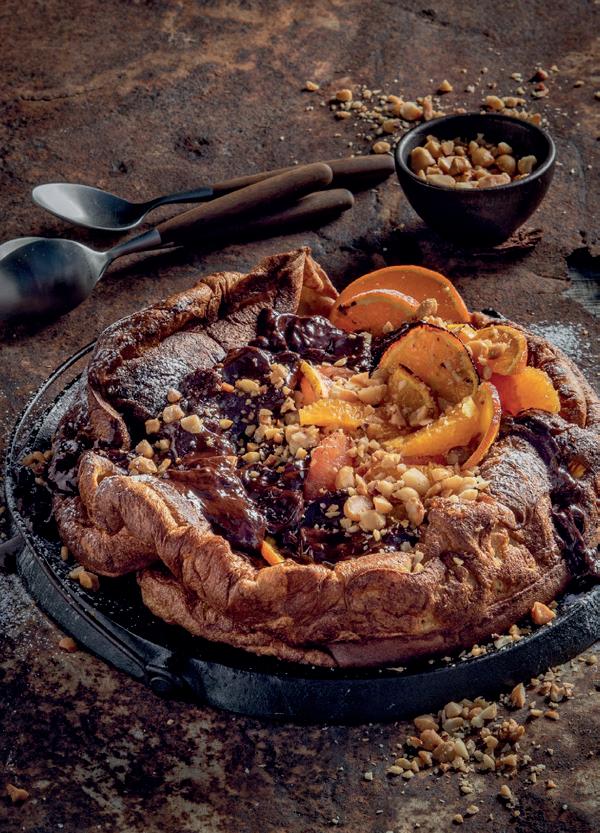
the mixture another good whisk. Remove the potjie lid and add a big knob of butter to the pot. Use a brush to move the butter around to coat everywhere inside the pot. Carefully pour the batter into the hot potjie and put on the lid. Spread out a few coals on top of the lid and bake for 30 minutes. Alternatively, bake with the lid on in the oven at 220°C for 25 minutes.
To make the ganache, chop the chocolate into small pieces and place it into a heatproof bowl. Heat the cream in a small saucepan over medium-high heat until bubbles begin to form around the edges. Pour the hot cream over the chocolate and let it stand for 2 minutes. Stir with a spatula to combine and form a smooth, glossy ganache.
WIN!
After 30 minutes, remove the potjie from the fire and lift the lid. The pancake will collapse in on itself. Let it cool for a few minutes, then carefully remove it from the potjie using a spatula and place onto a serving plate. Drizzle with ganache, dust with icing sugar, top with citrus segments and nuts, and tuck in.
Beer Pairing: Darling Brew Black Mist – it’s like they brewed this blacker-than-black porter, just for this dessert. With not-so-subtle hits of coffee and bitter dark chocolate, it contrasts perfectly with the sweet pastry and roasted nuts, and we all know what good mates orange and chocolate are.

Beer Country’s Pots, Pans & Potjies is out now.
One of two hampers made up of a six-bottle case of Nederburg’s new Double Barrel Reserve 2020, plus a copy each of Sifo: The Cooking Husband and Beer Country's Pots, Pans and Potjies by Greg Gilowey and Karl Tessendorf, all valued at R1 380.* To enter, scan the code using your phone camera, or visit www.penguinrandomhouse.co.za/competitions Ts & Cs apply. Entries close 30 June 2022. *Competition only open to individuals over the age of 18 years.
On my mind
I THINK ABOUT ESKOM EVERY DAY. WHY DON’T YOU?
Recognising that Eskom poses a singular threat to South Africa is vital to our country’s future – it leads to the inevitable conclusion that the power utility simply can’t cut it anymore, says Kyle Cowan, investigative journalist at News24 and author of Sabotage: Eskom Under Siege.
“Ican't stop thinking about Eskom. My family calls me obsessive and, arguably, they have a point. I have spent more than a year investigating key aspects of the electricity company as part of my work for News24 – work that continues –and have just written a book about the place.
I can almost hear the groans and feel the sharp rebuke of you rolling your eyes as you read this. Yes, it’s all desperately unexciting. The only time South Africans really care about Eskom is when the latest round of load shedding hits, and you are stuck trying to boil water on a small, one-plate gas stove as candles stutter because you forgot to charge the LED camping lantern.
The terrible truth is that load shedding, while inconvenient to us living in the ‘burbs, is not just annoying; it's damaging to our economy. And away from the suburbs, where spotlights keep some of the worst criminals at bay, it creates a far worse problem – for in the darkness, malcontent gains confidence.
Yet this fails to impart the terrible truth. We experience it tangibly, but load shedding is a symptom; a physical manifestation of the cancer that has eaten away at the heart of Eskom. Corruption, greed and incompetence have hollowed out Eskom’s capacity to keep power stations running well. A lack of money, a failure to start building new power stations early enough and a distinct lack of urgency around this problem have exacerbated the crisis.
Many words are spoken by our leaders in aid of soothing our ever-increasing frustration. But little progress is made. As I write this, it is 11 April 2022, and a few hours ago, a unit tripped
Our political elite are not focusing on Eskom enough.

is out now.
at Medupi power station plunging the country into stage two load shedding. One unit going offline pushed us over the edge. Others had broken down earlier and more units still were late in coming back online after outages for repairs. A staggering 15 000 megawatts of generation capacity was as a result of unplanned breakdowns.
I know this because Eskom keeps us in the loop on its struggles. The current leadership has realised that being open and honest about their problems goes a long way to quelling our discontent. It should not be this way.
We should think and write about Eskom only seldomly, because electricity is so ingrained in our way of life, that it should be a given. Yet we know about the troubles of Medupi, Tutuka and Camden power stations because we deserve an explanation when the power goes out.
In Sabotage, I argue that Eskom should be the first thing our leaders think of in the morning, and the last thing that crosses their minds before bed. I dedicate much of my writing to the efforts at cleaning up and fixing the problems, and I still get the feeling that beyond the thousands of dedicated Eskom staff who perform miracles daily, our political elite are not focusing on Eskom enough.
What greater danger exists to peace and security in South Africa, than an electricity company that struggles to generate electricity? Unfortunately, without fixing Eskom or providing an immediate, viable alternative, we are in immediate and ever-present danger as South Africa Inc.”
Sabotage
The best guidebooks on birds in our southern skies
